#peter conway promotions
Note
Recommend dinosaur media besides Jurassic Park?
Dinotopia: All the books are super fun, but the first and last are the best. Just some rambling, cozy journeys through an imagined land of prehistoric beasts and eclectic architecture. The middle two books are still great in terms of visuals, but they lean too much into narrative stuff and I don't think that's Gurney's strong point. The writing feels a lot more like a child's first chapter book. Maybe that's what he was going for, I'm not sure.
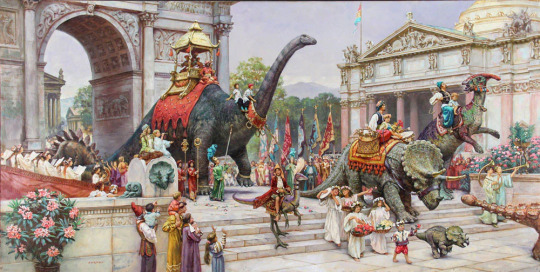
Xenozoic Tales: Long time fans of the blog will at this point be tired of me recommending it, but I'm not going to stop because most people I talk to (even other terminally-online SFF artists) still haven't read it. It's obviously super pulpy but it really grows into itself toward the end and is able to handle some more mature ideas without ever taking itself too seriously. Highly recommend.
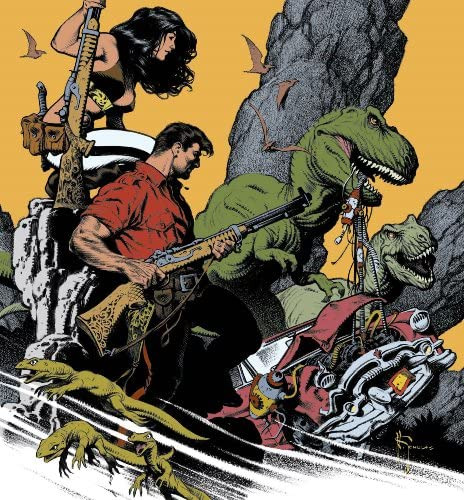
An Alphabet of Dinosaurs: Just a great collection of Wayne Barlowe's paleoart. It's a 10-minute read and it's aimed at kids but you're buying it for the art and its one of the only Barlowe books you can reliably pick up for less than $10 so I'd say it's worth it. Good chance your library may have it, too.
Dinosaurs by Thomas R Holtz Jr: Very accessible non-fiction work on dinosaur biology and cladistics. It's probably a bit dated now (came out in 2007) and the art is very hit-or-miss (about half the illustrations are obvious products of the era of early digital art when everyone was photobashing and throwing these awful digital textures onto everything, ugh...) but it remains a fun and informative read. If anyone has a more contemporary but similarly thorough dinosaur book, please let me know! I know there have been a lot of huge discoveries, especially from China, since this book came out.
C. M. Kosemen's (keep track of how many times that name appears on this list) and @simon-roy 's Dinosauroids: This was a HUGE influence on what I wanted to draw and what kind of stories I wanted to tell when I first found it and middle school and it still totally holds up. Check it out here!
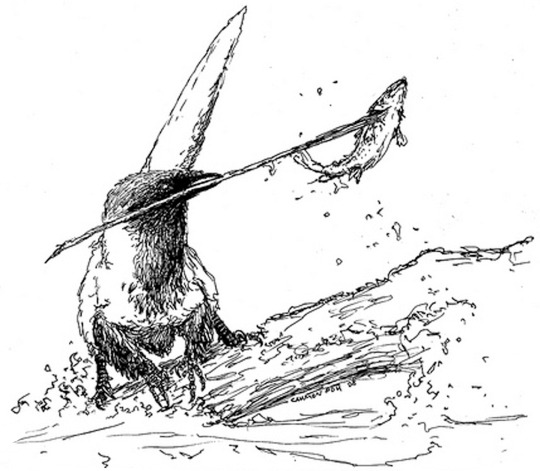
Walking With Dinosaurs: Huge, multi-part BBC documentary from 1999 that presented stories about Mesozoic fauna as if it was a contemporary nature documentary. The CGI for which it was initially so famous is very dated now but the practical effects are great and it's honestly the narration and presentation that sells it anyway. Also recommend Walking With Monsters which is the same thing but for the Paleozoic. People routinely upload both series on youtube, they're not hard to find.
All Yesterdays by Jon Conway, C. M. Kosemen, and Darren Naish: Unique and outrageous reconstructions of dinosaurs and other paleofauna that challenge our preconceptions and highlight the limits of our understanding of their appearance and behavior. Also really cool for me personally because in my lifetime I've seen this book go from a neat project by people I followed on deviantart to being (rightly) considered a landmark in paleoillustration.
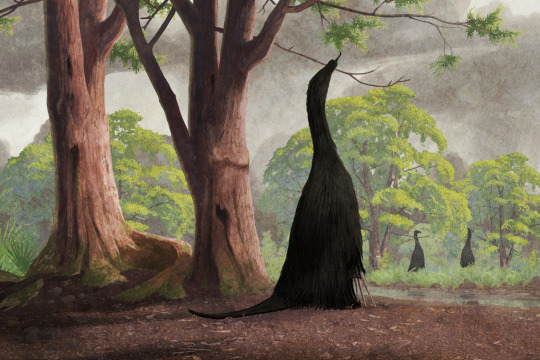
Dino Run: This game bangs and I pity the kids who weren't around in 2008 when this took over the internet for a brief but wonderful period
The Rite of Spring segment from Fantasia: From the big bang to the climactic end of the Mesozoic, all set to Stravinsky. Apparently the only Disney media I enjoy is stuff that The Mouse just does not give a shit about because this one's also on youtube.
That's some stuff off the top of my head, should be enough for now. I may add more if I think of it. Some parting thoughts:
C. M. Kosemen's youtube channel is great for learning about what I'll call "esoteric paleontology" for lack of a better term. Also he just does lots of weird, eclectic videos that I find interesting.
I don't hesitate to recommend Genndy Tartakovsky's Primal because he's literally never disappointed me and everyone I know says it's great, but I personally have not yet gotten around to watching it.
I don't promote pseudoscience, but I do think David Peters is a funny guy with weird, neat ideas. TLDR this one guy has a bunch of fringe theories about pterosaur biology and believes that because literally no one else agrees with him that he must be being censored by "mainstream science." Don't believe any of it, just enjoy the weirdness.
Any time you can pick up a dinosaur or other paleofauna book secondhand, I recommend you do it. Tons of outdated and cheap books that nonetheless contain great illustrations. That kinda stuff is a constant source of inspiration for me.
The Land Before Time is probably still great. It's been over a decade since I last watched it, but I have fond memories. Maybe time for a rewatch...

121 notes
·
View notes
Text
Into The Spider-Verse: Spider-Gwen (Edge of Spider-Verse #2)

Hello all you happy true beliviers! We're back into the spider-verse just in time for national women's month and the third of our main trio of spiders: Gwen Stacey, the spectacular Spider-Woman, referred often to as Spider-Gwen to disguish her from the various earth 616 spider-women before she was rebranded Ghost Spider.

Yeah Spider-Gwen is a lot to unpack, so let's take it from the stop. Spider-Gwen is a variant of Gwen Stacey, who you may remember from some adaptions as the Amazing Spider-Man films, being peter's prop for that hilarious dance number in spider-man 3 that's in my eyes even more rediculous than his saturday night fever schtick, and from cartoons appearing as an updated version of her classic self in Specatcular Spider-Man and as Spider-Gwen in Ultimate Spidey, Marvel's Spider-Man, Spidey and HIs Amazing Friend and Marvel Rising.
For those less familiar with the comics, Gwen Stacey was peter's very second love intrest. Gwen was introduced late into Steve Ditko's run as one of the mileu of jackasses constantly taunting peter parker, this time as he entered college. As seen with Amazing Fantasy at the time peter was a loner Dottie, a rebel, who was mostly picked on. He had one girlfriend briefly, Betty Brant, but after her brother died she became paranoid about him taking pictures of spider-man, blaming spider-man for his death and worrying he'd lead to Peter's.
So really.. Aunt may was all peter had for the first 30 or so issues.
Once Ditko left though Lee decided to shake things up as peter had entered college. Since new Artist John Romita drew characters a bit more handsomely, he decided to expand peter's friend group: Harry Osborn, who picked on him previously, decided he had it wrong about peter and genuinely tried to befriend the guy, serving as a nice contrast to the various assholes. It also made sense: people who are withdrawn or feel trapped in the high school hiearchy can often find friends easier in College, where people may be open to trying new thems or not bogged down by history. Granted Peter also had flash there as a rival , Lee coudln't take all his pain away or he woudln't be peter, but he now had a friend.. and soon had love intrests.
Peter soon ended up in a brief archie style love triangle between Mary Jane Watson, at the time a viacious party animal who'd been oft hinted at in a running gag where May tried to set them up and Peter assumed "nice girl" meant

Which has aged like fine egg left on a sidewalk for 9 days. This is where Gwen came in. Gwen like harry realized she might of misjudged peter especially after finding out he snubbed her and harry at first because Aunt May was sick, as part of the legendary "If This Be My Destiny" three parter. The two dated for a long time and she was a fan faviorite with many of a fan, some who'd get promoted to managment, preferring her over MJ. The thing was in the original comics.. Gwen was pretty one note. She was just "nice" and "love intrest".
See while stan lee was good at MANY things, creative worlds, working with great artists, showmanship, coming up with brilliant premises for characters… he was absolutely awful at writing women , at least during the silver age. Most of his women's main trait's were "love intrest" or "girl" or "getting overly emotoinal". Their powers were often limited as was their influence, with sue storm ONLY being able to turn invsible at first before gaining her forcefields, and Jean Grey's telekensis being very limited. While Janet Van Dyne got better with her stings and stuff, she was often depicted as flighty. Gwen is , as you can see, far from his worst but is just kinda there to be the "good girl" in contrast to mj at first, then to just cause friction with peter whenever his double identity impcats their romance. She was a plot device, not a person.
She kept on like this till a new writer jumped on board Gerry Conway. Conway had decided someone needed to die as it'd been a while since uncle Ben and while George Stacey, gwen's dad, had in the line of duty, he wasn't close to peter and was mainly killed to drive a wedge betwen him and Gwen. So he ended up deciding on Gwen to both motivate the poor boy and to clear up the cast a bit. So Gwen became famous.. for her death, the legendary "The night gwen stacey died" which I showed the utmost respect and reverence to in my amazing fantasy #15 review

The story is incredibly well crafted though, and the art is gorgeous. It's only weakness.. is being a MASSIVE example of Women in Refregirators syndrome, with Gwen being killed to motivate peter and not having any real agency in her death. Said death at least would haunt peter for the rest of his career and still comes up on occasion. There were clones, terrible retcons not worth mentoining and other things involving gwen, but she remained dead and still is…. in the 616.
Thankfully marvel had a merry multiverse and Dan Slott had plans to explore that in an upcoming event comic Spider-Verse, which while sharing a name and vauge premise of uniting a bunch of spider people with the movie, is nothing like it and involves the spider-person hutning inheretors. I have not read it as it was at a time when Dan Slott's run on the book took a massive dive, so I can't really speak for it's quality. But good event or no it did give us a lot of great new spider-people to go with established variants like Spider-Ham, Spider-Man 2099 and Spider-Man Noir, and Gwen was one of them.
Gwen was an editor's suggestion and a brilliant one: Take the biggest victim in spider-man history , and make HER the one who gets bit by the spider. All Dan Slott really had was the idea to give her a trench coat costume and the red and blues, but the actual making of her went to Jason Latour.

For context as I found out in my research… Jason Latour is a sexually harassing creep.
At 2017's Thought Bubble fest, he followed around artist Lauren Tracey who at the time was in her early 20's to his 40's just to add to it, and stalked her, then kissed her against her will. After Tracey revealed the allegations, Latour tried to claim he didn't remember the incident.. only for tons of others to come forward and reveal he was also creepy twoards them or friend sof theres. They likely knew.. but didn't have the power to come forward. Latour weakly apologized and hasn't worked for Marvel since. It was deeply disapointing to find out someone I respected… was an ashole who used his power to harass women, make them feel deeply uncomfortable and affect their careers. He was one of MANY in the industry who did this and I doubt he'll be the last I talk about but it's super depressing he used his power like this and he can promptly fuck himself.
I won't be letting this affect my judgement of the comic itself. It's hard and i'll likely look like this the whole itme i'm typing this
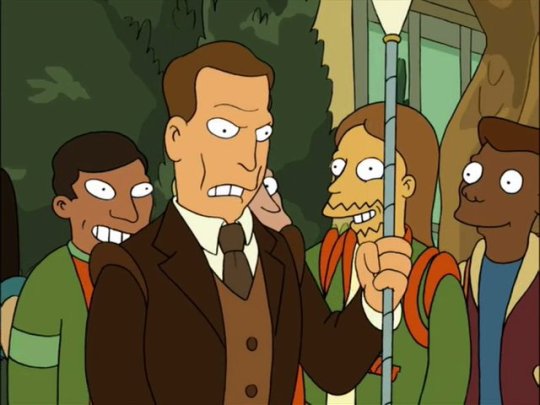
But I have to judge the issue by it's own merits, while still stressing the creator isn't to be worshipped. It's a good object lesson to remember that terrible people can make good art. I try to avoid covering that art to glorify them. It's why despite being a massive x-men fan and having grown up with the story you likely wont' see Joss Whedon's Astonishing X-Men covered on here unless someone comissions it. Like this it's an important part of comics history and can't just be.. forgotten, but the creator shouldn't be on any sort of pedestal for it unless he truly and completely has repented for what he's done and even then what he's done shoudln't be forgotten in the process.
Now getting into Prailne's and Dick's creative process, Pralines and Dick decided to really swing for the fences. This was an alternate universe.. so he decided to make it really alternate. Instead of a cheery if often weepy coed, Gwen was a troubled college freshman who was reseved and steady out of costume and freer in it.. at a terrible cost. He and Rodregiuz gave her a hood to symbolize the weight she carries and acccents of purple and blue to really help the costume pop against the white, while also giving her the mask to keep up the "anyone can wear the mask" motif from Peter and Miles.
The result wasn't a hit with Dan But he ended up eating his words and fully agreeing they made the right call. The result was an INSTANT hit from her first apperance and quickly got an ongoing. I MIGHT talk about it in the future, it's tricky with Pralines and Dick being the writer. For now though let's go under the cut and into the spider-verse as we explore the startling origin of Spider-Gwen.
So we open with Band Practice for the Mary Janes, the band Gwen is drummer for. Her bandmates are naturally this universe's Mary Jane Watson, along with Glory Grant, a friend of peters in the main universe who worked as Jonah's asstiant and Betty Brant, who I previously mentioned and also worked as Jonah's assitant.
The band plays their signature , and likely only, original song,
youtube
I mean that would rule but naturally instead it's called Face it Tiger. I.. I will neve rbe tired of that being a thing nor imagining waht this riot grrl esque song sounds like in my head. Pralines and Dick makes a smart move here: instead of just having the issue go through Gwen's origin, like it seems what other one shots of edge of the spider-verse i've glanced at do, we get the origin in one beautiful two page spread, told quick, susicntly but still with enough emotoinal punch. We get some of the blanks filled in later, but it's enough to make the story work and get a sense of who THIS gwen is.



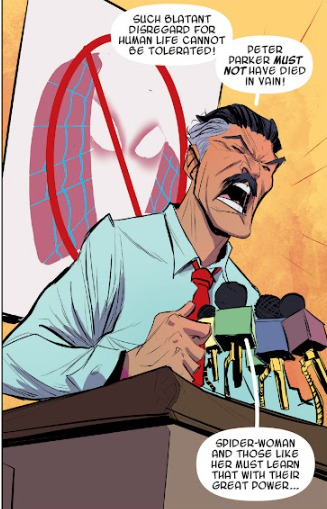
I also like all the small touches here: the times square having advertisments for Janet Van Dyne with her wearing her classic outfit and signifying she's still the wasp here, and Dzzler. Just little nods. I also like the MC Hammer joke.
On the origin itslef it's great following most of the same beats btu cleverly twisting peter parker: We saw what he was during Amazing Fantasy: he was resentful, alone, and had no one. Here we see where that might of gone where he instead ends up as the alternate version of one of his own villians, dying tragically trying to be popular and loved like Gwen's alter ego.
Glory gets gwen to snap out of it but she can't open up for obvious reasons. MJ here.. is more of a dick, lacking the main universe MJ's better nature and instead being a snippy mean girl.
We then get a fairly sad scene of reflection, of Gwen sitting on the billboard, feeling it was her fault peter died. Much like with Uncle Ben and our peter, that's not necessarily true, but you can undrestand her guilt: he followed in her example. her DEFENDING him isn't her fault, nor him feeling insecure over it, that's just good ole toxic masculinity, but she still went into it for wealth and fame and showed what someone trying to do the same could end up as.
We then get her talking to her father, who views her music more as a distraction, and wants her to focus, while Gwen understandably.. dosen't want to do that. We also find out George Stacey.. is the one hunting gwen.

We also get a nice brief scene of her and a cop trying to shoot her. She webs him up and wisecracks ab it, showing she's far more assertive behind the mask and gets some freedom from it… though it also feels like a coping meachanism, a way to avoid the pain she's going through from Peter's death and her own father hunting her and not supporting her. To try and use the freedom much like peter does to shake off her torubles. It's this kind of thing that shows Pralines and Dick REALLY gets what makes a spider-man story work and what makes these some of the best.
So we cut to our villians for this issue: The Rhino and Matt Murdock.

Yeah one of the bigger swings of this universe, and one of the reasons I enjoy it so much, is that rather than just go the normal alternate universe route we see in most comics of "this reality but one things diffrent", Pralines and Dick switches it up and has a BUCNH of little thigns be diffrent that are not remotely impacted by the fact Gwen is who she is here: The Fantastic FOur are non existant with Ben Grimm being a cop while Reed Richards is a child progedy, Wolverine and Kitty Pryde are shield agents with Logan being a functionally immnortal samurai, Howard T Duck is the president of the united states, and Janet Van Dyne is retired from superheroics and instead super wealthy, Sam wilson is a woman and the captain america who came here from the 40's, and so on. I love how many swings this place takes.
Matt Murdock is the biggest though: instead of becoming an upstanding young man, he was blinded in an accident that also killed his mom and his dad's death happened earlier.. and the Hand got a hold of him. As a result this Matt is everytihing the 616 matt isn't: cruel, selfish while still being every bit as compitent and charasmatic and as we find out later, EVERY bit as powerful. Matt is Gwen's arch enemy and the big bad of this universe, serving as the mouth of sauron for the kingpin.. while clearly planning to dethrone his old boss nad rule.
As for what he's up to with Rhino, whose grey skinned here instead of in a rhino costume it's simple: He's putting a hit out on George. He wants him dead both because the Good Captain's an issue for their operations and general.. and as an issue for Spider-Woman he could be leverage to bring her on their side.
That night it's a concert and instead of waiting for gwen whose just a tad late.. her band goes on anyway

Gwen soon has bigger issue's though as The Rhino shows up to kill her dad and while she's able to stop that, he bear hugs her, nearly crushing her.. but like any spidey, she has a near unstoppable will in he and thus cleverly beats him.. by drumming her way out.


She then FINISHES it by punching the fucker through a wall.
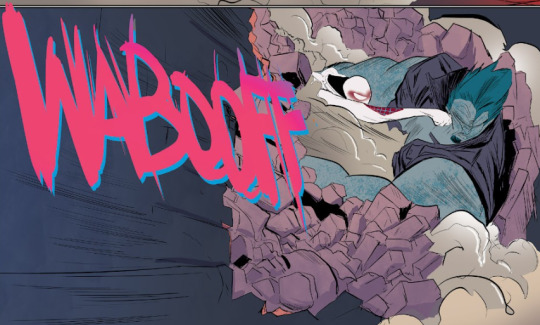
God damn is every spider person's first fight going to one up the next one? I mean we've gone from scaring a thug to near death, to fighting an electric man who knocked out their universes avengers equivleent with ease, to drumming a guy , beating him some more than putting him thorugh that fucking wall, Frank Murphy Style. By the time we get to spider-ham is he just going to whip out a machine gun on funny animal mysterio? We'll fine out I suppose
It's here I gotta stop to comment on Robi Rodregueiz' art. It's gorgeous, stylezed, being very remincent of ditkos but with more of a colorful pop to it. It's kinetic, in your face and perfect for the character and a large reason why i didn't nope out of this; the character isn't just good because of Pralines and Dick, but because of Rodieguesz art really caputring her form her pain to her punches perfectly.
SO gwen saved her dad.. problem is her dad dosen't know it's her and believe sin due process. Gwen rightly points out the problem in that: she didn't kill peter but thanks to JJJ a blood thirsty mob thinks she did and will try and kill her before trial, and that's not getting into the cops who tried to shoot her on sight. Captain Stacey vows to bring her in no matter what it takes.. so Gwen has to pull her trump card, throwing earlier words he said back at him.
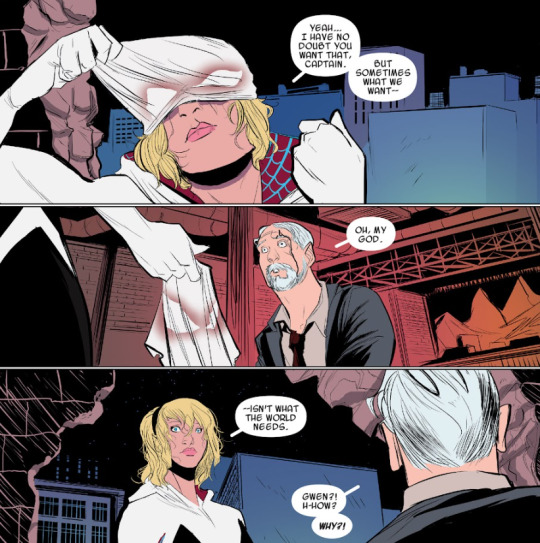
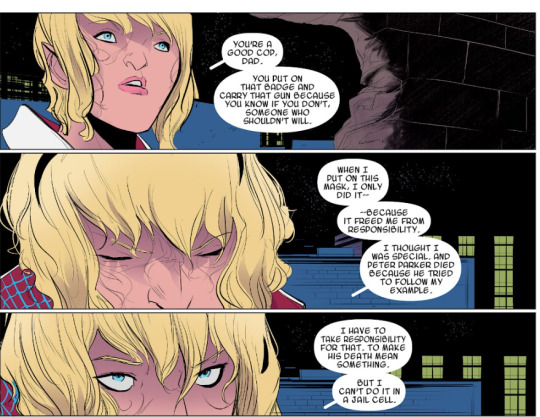

It's a beauitful speech that sums up why she's like this: it's her responsiblity> She has the power, she has to use it and going to jail just to prove she's innocent helps no one. Her innocence helps no one. But this.. this can help everyone. George reluctantly lets her go and an emotoinal ending, Gwen's father letting her go both of their futures uncertain and their relationship as father and daughter even more so…. is undercut a bit by this guy.
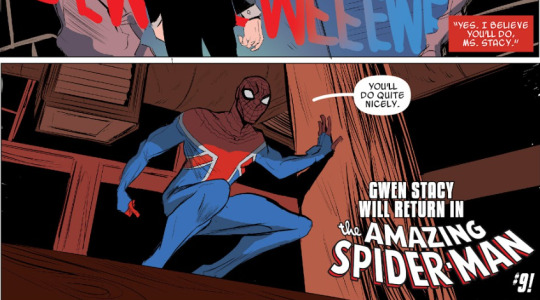
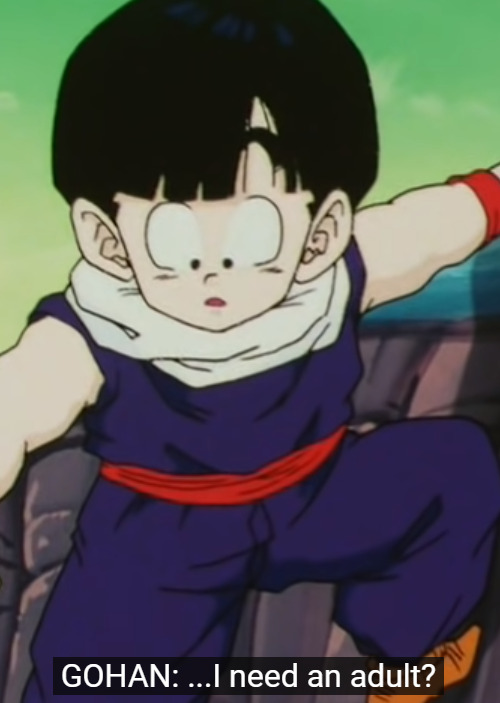
Yeah look I know who this is, Spider-UK he's also a captain britan, defenders of the crown and the multiverse, long story that naturally for me is x-men adjacent. But to anyone coming in just to see this character after one of her many adaptation apperances or just ucrious is going to be fucking confused. I get this wans't MEANT to lead into an ongoing.. but even story wise puncuating a heartwrenching ending with british spider-man creeping on some random balcony shadowed ominosuly makes him come off more like he's going to add Gwen to some horrifying collection than you know, recurit her to save the universe.
Gwen would go on to the frequently hinted at ongoing and greater hearts btu as a start.. this issue is fantastic. It gets who she is across quick, makes her distinct from our gwen, and all the better than her honestly, and sets a lot of what would make the character famous in stone. It's not a huge shock every version of gwen since has been this nor that this is one of the best spider-man stories in the last decade. Pralines and Dick may suck.. but this story dosen't and is worth checking out for the art alone. Just maybe get it second hand or something.
Next Time we thankfully have a creator who HASN'T sexually harassed a woman as next week we take a look at SP/DR from my boy Gerard Way. Until then keep on swingin and thanks for reading.
#spider gwen#gwen stacey#ghost spider#robbi rodriguez#marvel comics#spider-man#matt murdock#george stacey#peter parker#earth 65#matt murderock
22 notes
·
View notes
Text
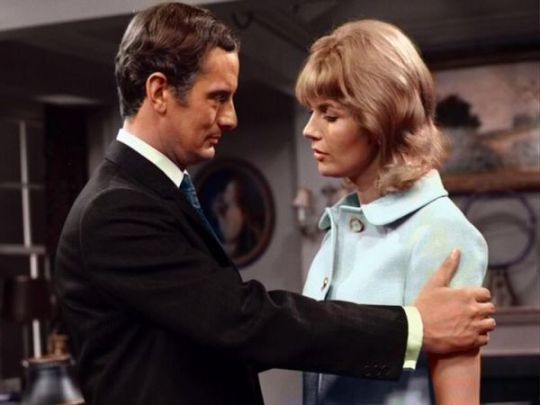

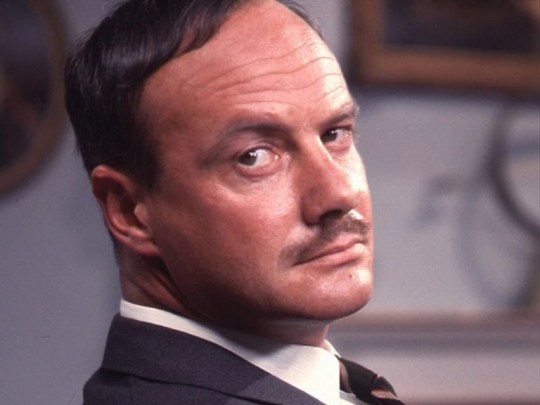



Out of the Unknown: The Yellow Pill (3.12, BBC, 1969)
"The year is 1969. This is 1969, this is the year in which you claim to have been born."
"You really are gone, aren't you, old boy?"
"Look, Connor, if I were to show you a calendar, or a newspaper, which clearly shows today's date is June the fourth, 1969, will you believe me then?"
"No."
"Why not?"
"Because this job we're doing is difficult enough, and sometimes everybody doubts his or her reason. The pressure's on all the time, so you have to cling to certain unalterable things - like your name, the date, the names of friends! Now, I know what year it is, do you understand that? I know!"
#Out of the Unknown#The Yellow Pill#Single play#Missing TV#Rog Phillips#Leon Griffiths#1969#BBC#Michael Ferguson#Francis Matthews#Stephen Bradley#Angela Browne#Glynn Edwards#Steve Peters#James Haswell#Carl Conway#Our last surviving s3 episode! Again this is an audio presentation of the surviving soundtrack set to promotional photos taken by the BBC#The Yellow Pill had actually been adapted before for Out of this World‚ the Sci fi anthology which acted as the catalyst for OotU and which#Had brought Irene Shubik recognition in the first place; sadly that version is also lost‚ audio as well. This is maybe the most successful#Of the audio presentations simply because of the brevity of plot and staging: the whole thing is largely conversational and set in one or#Two rooms‚ and in fact if you were adapting the story as a radio play there are very few differences you'd need to make to Griffiths'#Script. That's not to say this is an overly simple tale; actually it feels very 60s‚ classic mindbending look at what constitutes reality#And how one can be sure that the real world is‚ well‚ the real world. The Matrix meets Inception but on a BBC budget and starring Captain#Scarlet. Matthews is very good actually; there's a cleverness in casting here so that Matthews and Edwards are both playing to type (as a#Haughty psychiatrist and a rough policeman respectively) but it's very much a conscious decision: after all the plot hinges on whether#These ppl are actually real at all or whether they're a form of fiction (meta casting in a way). There's room in the story (and seemingly#From reviews in the previous adaptation) for a degree of uncertainty in the final reveal (again think the end of Inception) but this#Version‚ for better or worse‚ plays it straight.
9 notes
·
View notes
Text
D3: The Mighty Ducks (1996) is the best Ducks movie and a flawless coming of age movie
It’s no secret that The Mighty Ducks are a beloved trilogy. The three films spawned a professional NHL team named in their honor, 2021 sequel series, as well as many knockoff films released in the 1990s. But with any movie series, fans tend to rank the films and have passionate opinions on which is the best. For most Ducks fans, the answer is simple: D2. It has the Bash Brothers, Team USA dominating, the iconic “Ducks Fly Together” scene and two Queen songs. What’s not to love? But upon a rewatch of the trilogy, I came to realize that it’s not D2, or even the original, that is the best in the series.
It’s the criminally underrated 1996 D3 that for me, is the most mature and has the most heart. Perhaps it’s that the Ducks are now old enough to carry their own weight on screen. Perhaps it’s that the film takes a look at trauma, specifically trauma in teenagers, and how that manifests itself. Perhaps it’s that the film is maybe ahead of its time, in the way it discusses classism, racism and sexism. There is so much about this overly hated film that makes it the best Ducks movie and a perfect coming of age film.
The movie starts presumably a few years following the Ducks’ win against Iceland. They all look noticeably older - definitely older than the middle schoolers we left behind in 1994 - and all of the male Ducks’ voices have dropped a few octaves. Gordon Bombay, played by Emilio Estevez, is presenting the team (except for unfortunately, Jesse Hall, a leader among the Ducks who would’ve made for a strong presence in this mature film, as well as Portman, but we’ll get to him later) with scholarships to his alma mater, Eden Hall, a preparatory high school in Minnesota. Charlie Conway, played by a young, pre-Dawson’s Creek Joshua Jackson, is the Ducks’ captain and unspoken leader. There’s been much debate over the years over whether or not Charlie is the true captain of the Ducks. Adam Banks, played by Vincent Larusso, is far and away better than practically every Duck combined. Fulton Reed, played by Elden Henson, has shown more maturity and leadership at this point. It’s probably true that the Ducks as a team think that Charlie is Captain because of Bombay’s favoritism towards him (and his mother), but I think that this film makes it abundantly clear why Charlie is the captain.
D3 is Charlie’s story. We see that in the opening scene, when Bombay tells Charlie he will not be following the team to Eden Hall, accepting a job instead in California. We learned in the original Mighty Ducks film, that Charlie and his mother left a bad situation in Charlie’s father when Charlie was very young. We also hear about Charlie’s mother, Casey’s marriage to a new man in the D2, who we can assume from what Jan says, that Charlie doesn’t like. We see in that first film, Charlie’s reaction to Bombay announcing that he is leaving the Ducks after the two of them have formed a bond. It is very clear that Charlie deals with abandonment issues, stemming from trauma in his early childhood. Charlie freaks out when a D3 Bombay announces the same thing, and storms off.
Change is the biggest theme in D3. We see how change affects each of the Ducks, even those who don’t get many lines. Some, like Russ Tyler, played by SNL’s Kenan Thompson, think it’s a good thing. All of the Ducks don’t come from good neighborhoods and we assume that most of them don’t have the best home lives, especially when Charlie tells their new coach, Orion, played by Jeffrey Nordling, that the Ducks are the only good thing that any of them have had. Going to a preparatory school should be a good thing for them. But for most of them, it’s not. The new Ducks (who by the way, three of which are people of color, and one of which, is a woman) are immediately told that “their kind” is not welcome at Eden Hall. The Varsity team claim that they feel this way because the captain’s younger brother was not admitted onto the JV team because of the Ducks’ scholarships, but it’s very clear what they really mean. Russ commented that he’s the only black person on the whole campus earlier, and he, Luis Mendoza (The Sandlot’s Mike Vitar) and Ken Wu (Justin Wong) are the only people of color we see in the film. Change takes a toll on each member of the team. We see it the most in Charlie, but we also hear from Fulton on how the separation from his best friend, Dean Portman (Aaron Lohr), who decided not to enroll at Eden Hall, is taking a toll on him. Connie (Margerite Moreau) and Guy (Garrette Henson) have presumably broken up, as the two small scenes we get of them, they are arguing. It’s a transition period, one that the first year of high school often is. But it’s also a look on how a rich, white privileged world is vastly different than the one that the Ducks are used to.
Coach Orion seems like a hardass, especially when he tells Charlie at their first practice that he will no longer be “Captain Duck” (as coined by D2’s Gunnar Stahl, played by Scott Whyte, who now plays the level-headed Varsity goalie Scooter). This, to the Ducks, is a line in the sand. Ever since Bombay turned District 5 into the Ducks four years previous, Charlie has been their captain. They’re in a whole new environment, where the man who gave them so much happiness and so many friendships isn’t, and their “little Duck tricks” won’t work anymore. Orion thinks Charlie is a showoff, and perhaps he is. This Charlie is vastly different than the sweet, shy Charlie we see in D1 and D2. But this Charlie is older, has just been abandoned by a man he considered a father, and is being harassed on a daily basis for being, as Varsity Captain Reilly puts it, “white trash.” I find it hard to believe sometimes that fans can look at Charlie from the outside, and not see who he is on the inside. All of Charlie’s closest relationships that we see portrayed in this movie, are with women. His mother (who he, as a teenage boy, says “I love you” to in the final scene of the movie), his teammates, Connie and Julie, who he gets a lot more screentime with, and with new love interest, Linda (Margot Finley).
I think now is a great time to talk about the shockingly impressive way all of the female characters are portrayed in this series, particularly this movie, especially for a 90s sports film. Connie has always been a leader on and off the ice. She’s in a relationship with Guy, but it’s not her only character trait. Dubbed “the Velvet Hammer” by Averman (Matt Doherty), she stands up for herself, and for her shy teammates (she literally shoves Peter Mark - a character cut out of D2 and D3 for good reason - in D1 when he insults Charlie) and stands up to the entire Varsity team despite them telling her that they hope they can “fight” with her later. Julie “The Cat” Gaffney (Columbe Jacobsen) is the second best player on the Ducks, despite the little ice time (thanks, Bombay) we see her have. She is the first person to tell of the Varsity, telling Captain Reilly that his little brother “just wasn’t good enough.” She’s a huge facilitator in the fire ant prank and despite the very weird and out of character game she had against the Blake Bears, shows that she deserves the number one goalie slot that Reilly gives her - despite what Goldberg, and the obvious underlying sexism there, have to say. I’ve also always been very impressed with Charlie’s mother, Casey (Heidi Kling). Although she has a romance with Bombay in D1, she makes it clear from the get go that her first priority is Charlie. We know that she took the two of them away from an abusive situation, and she’s a goddamn hero for that. Her scenes in D3 are limited, but they always show her chastising Charlie’s antics and encouraging him to stay in school. It goes unsaid, but it’s clear that she knows that he’s not going to get an education this good in the problematic public school system. But according to Linda, Charlie’s love interest, the private school system is no better. The first time we see Linda, she is protesting the “outdated” Warriors team name. This was in a 1996 kids movie, no less. She holds her own against Charlie, calling him out when he’s wrong. No one aside from Charlie, and maybe Fulton, get much screentime or lines aside from Bombay and Orion, but her presence and the point of her character is clear - not every rich person agrees with the horrible things that wealthy people do.
Back to the plot.
When the Ducks receive their positions, they learn that Banks, as a freshman, has made Varsity. From an outside perspective, they seems obvious. Banks is the best player we see in any of the films, definitely miles better than the losers on Varsity, so it seems obvious that he would be promoted. But Banks is unhappy with this. Adam Banks is a fan favorite character, definitely due to the sweet, understated performance by Larusso, but we don’t see much of him. From what we do see of him though, he underwent a huge character arc from D1 to now. In D1, Banks goes against his father’s protests and joins the Ducks, claiming that he “just wants to play hockey.” Here in D3, we see that Banks is utterly miserable despite playing with some of the best players in the state, purely because he’s not with his friends. At the end of the film, he makes the (questionable) decision to rejoin the Ducks and go against the Varsity. But Varsity seems to feel that Banks fits in with them, for obvious reasons. He’s the only Duck who comes from an affluent background, and he’s definitely the most clean cut. Captain Reilly is visibly angry in the final showdown with the Ducks that they no longer have Banks on their side, as if he’s betrayed “his kind.”
The turning point of the film comes when after Charlie has quit the freshman team (no longer the Ducks), Hans, a father figure to the Ducks and Bombay, suddenly passes away. It’s an insanely dark moment for a Disney film, especially when Bombay returns to the funeral and reminds the Ducks that it was “Hans who taught them to fly” and Charlie storms off, crying. I think Joshua Jackson, in the Ducks films, as well as in Dawson’s Creek, is phenomenally good at portraying teenagers who wouldn’t normally be seen as leading men. Who let their emotions overtake them, who have anger issues, who deal with familial problems. Characters like that in leading roles were almost unheard of in the 90s, and in the upcoming scenes, it reminds us why this side of Charlie that we’ve seen throughout the movie is not the only side of Charlie.
Bombay takes Charlie to the rink to see Orion skating with his disabled daughter, who was injured in a car accident. He reveals to Charlie that Orion quit the NHL to take care of her, and this immediately changes Charlie’s opinion of him, but he’s still unconvinced about rejoining the team. The next scene is without question, the greatest and most important scene of the trilogy. The last two films spent way too much time telling us how great of a person Bombay was, how he was the Minnesota Miracle Man,despite us seeing so little of that onscreen. We see him making mistake after mistake, hurting the team, being an unjustified dick to those around him. But this scene more than makes up for all of that. I’ve put the quote from this scene below.
Bombay: I was like you, Charlie. When I played hockey, I was a total hot shot. I tried to take control of every game. I wound up quitting. So I tried the law. I ruled the courtroom, but inside, I’m a mess. Start drinking. Man, I was going down. But then this great thing happened, maybe the best thing ever - I got arrested and sentenced to community service. And there you were - Charlie and the Ducks. And as hard as I fought it, there you were. You gave me a life, Charlie, and I want to say thank you. I told Orion about all of this when I talked to him about taking over. I told him that you were the heart of the team and that you would learn something from each other. I told him that you were the real Minnesota Miracle Man.
Charlie: You did?
Bombay: I did. So be that man, Charlie. Be that man.
It’s a callback to D2, when Jan tells Bombay “Be that man, Gordon. Be that man.” This scene is flawless. Every good thing that has happened to the Ducks, came because of Charlie’s heart. It came because of that game when Charlie refused to cheat, and made Bombay see his wrongs. It came because of when Bombay first tried to quit the team, and seeing how hurt Charlie was, agreed to stay. It was Charlie who stepped out of the game against Iceland so that Banks could play. It was Charlie who found them Russ. Giving the credit to a young, emotionally unstable teenager, rather than their Emilio Estevez, hotshot Bombay, is the best thing this series ever did.
This movie, in my opinion, is nearly flawless. Every moment has been planned to make the same point - change sucks. Especially when you’re a teenager. Even more so when you’re a teenager with trauma.
49 notes
·
View notes
Note
Opinions on hair clip!Gwen vs MJ bangs!Gwen?
(Personally I think that the hair clips give off some kind of vibe and I don’t know what it is but it’s definitely there)
Very niche topic you were correct to guess I would have involved, impassioned thoughts about.
(Quick visual rundown of the history of Gwen’s hairstyle for the normal people out there:)
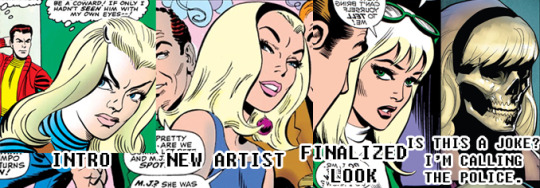
Aesthetically, of course the bangs are superior. At least some of why the headband and bangs look is iconic is because it’s a Look™. But that’s not...the point.
Copying MJ’s hairstyle - and then immediately needing to return to having something holding her hair back and experimenting with how to do that with short bangs for a while - is one of those little things that makes Gwen feel like a person despite her comparatively minor volume of appearances. It’s just such real social circle of 17-19yos behavior. Her smiling on the outside despairing on the inside face when Harry points it out??

Agonizing. I love it.
(Digressing but the panel immediately before this where Harry is like, “Peter, in my unprofessional opinion I diagnose you with Every Single Disease.” I love this era.)
Simultaneously, the vibes of Gwen stealing her hottest friend’s look? Her hottest friend who her other hot friend is clearly attracted to’s look?? Girl was really going through it. [Here I tried to casually insert a bi flag emoji, but there isn’t one.] Every leg of this love triangle-cum-OT3 is real.
So I love all of that, and you sacrifice all of it when you act like Gwen was born with a black headband fused to her skull divorce the bangs from their context. Having her already sporting the hyper-recognizable fringe look in high school is my sole critique of what we got of the Gwen Stacy solo title. (Marvel, please? The rest? I am but a starving Victorian orphan--) I was rooting so hard for acknowledging her awkward high school senior hair.... Like to a weird degree probably. I was texting people updates about the projected likelihood of the established hair continuity being adhered to as new promotional art dropped.
Because the clips are valuable shorthand to convey what era of Gwen you’re looking at! The sharp corners and exposed widow’s peak and old fashioned bit of curl tell you right away you’re looking at a less settled Gwen, someone with only one firm friend who, for all she’s remembered as a bookish sweetheart, did very much and by her own design hook up with Peter via an enemies-to-lovers route.
Gwen was MEAN when she was introduced! You can’t use the clips without remembering Gwen being mean, which honestly I think everyone writing her should take a couple of minutes a week to do, for health reasons. (Sometimes it’s for reasons of my health, as a reader.) I talk about how Peter/MJ is bitch4bitch and the poetry of two liars being honest only with each other, but Gwen and Peter? Very much united by a shared passionate drive to deck the world hard in the face and watch it bleed. And also science or whatever, I guess.
I don’t read Gwen as becoming a less intense, angry character through the different micro-eras you can mark by her hairstyle, but she gets more comfortable with the rest of the core cast while also picking up a thread of melancholy. (Okay sometimes...you have to read against the text a little to reconcile it with itself.) The sum effect of this mix gets flanderized into characterizing Gwen as a Good Girl, and when creators go with the headband look for periods where Gwen-the-character would be wearing hair clips, you know that even if they’re writing good content they view Gwen as a Good Girl who was Too Good For This World who would never ever start a petty feud or or insult someone who doesn’t deserve it or escalate a situation into minor violence. (Because, you know, women must not cause narrative drama by wanting things, only by being wanted.)
...More charitably, it’s just not going to hit the same, because it’s a sign the team is working with the concept of Gwen without either enough affection for or knowledge of her personal history to adhere to it. If you keep snipping bits out of her like this, you’re going to run out of girl pretty fast.
The silver clips anchor things in an era where there’s a greater discomfort with themselves in the whole cast and they’re all taking it out on each other. THERE IS DEFINITELY A WHOLE VIBE.
Also the style is actually very fun to draw, in my experience.
I’ve been sort of talking around the Doylist angle -- I think it’s excellent how much the progression of Gwen’s hair works from a characterization standpoint, given how every single minute change is very clearly a creative team shift thing. Horror art style to romance art style followed by whatever Stan Lee was doing to whatever Gerry Conway was doing had an effect on how the first stretch of Spider-Man reads you just. Could not bottle. Most of Gwen’s look shifts are very blatantly an ongoing series of nudges deeper into Romita Sr.’s favorite things to draw -- which incidentally looked excellent, so who was going to complain?
Of course, then if you continue with a meta lens beyond the JRSr era...the bangs look depreciates considerably! I was originally planning for that infographic at the top to do much harder double duty as a joke, with more images in between the last two. Death! Every single clone! Spider-Gwen! Flashbacks set before the bangs! But it’s like! How much effort do I really want to expend just to lampshade that her style has been frozen for 45 years!? Also it wasn’t going to be worth it without the skeleton as the punchline, so I had to go get that first because it was the only one I hadn’t actually seen personally, and finding it really sapped my energy for balancing good-natured ribbing with deep appreciation for a topic. I was kind of hoping people on Twitter had made that up!
Like. God damn. It still looks good, but the overlap with not really empathizing with this character or getting into her head is intense. Every day I thank Into the Spider-Verse for its bid at unfreezing Gwen’s hairstyle for the first time since 1973.
So like, yeah. I like looking at the bangs look slightly more, but adhering to them fanatically is refusing to use all the weapons in your arsenal. And to all the Marvel writers using the bangs while simping for either side of the Gwen vs. MJ thing: That’s MJ’s hairstyle, and that’s a little gay.
108 notes
·
View notes
Text
The Whole Marvelous Super Ultra Cosmic Magical Comic Book Universe
The produce of imagination and business that was Marvel Comics was a synchronic harmony sounded by Stan Lee and Jack Kirby and Steve Ditko and every one of the creators and craftsmen and inkers and colorists who worked there. Everything began during the mid 1960's the point at which the Fantastic Four and Spider-man and the X-men (The Uncanny X-Men) were framed from the creative mind of Stan Lee and Jack Kirby.
X-men was a film industry crush the previous summer. I'm certain you additionally recall the profoundly effective Hulk TV show.
The most punctual X-men comprised of Jean (Marvel Girl) Gray (who later turned into the amazingly well known Phoenix), Professor X (Xavier), Cyclops (Scott Summers), the insightful Beast (Hank McCoy), and Iceman (Bobbie). Freaks brought into the world with exceptional "super-freak" capacities.
Later came the New Mutants with more youthful characters having freak controls that occasionally appeared to have them (the main sort of comic book story I don't care for).
These characters from X-men including (Nightcrawler, Wolverine, Storm, Banshee, Kitty) advanced with the appearance of the imagination of John Byrne (beginning in issue #108 of X-men) and Chris Claremont (Giant Sized X-men #1 and Uncanny X-men #94 now esteemed at $500. up in "mint" condition. The most famous person was the principle star in the X-men film- - Wolverine. There makes certain to be a continuation for this film industry crush.
X-men Comics instructed kids that bias is shrewd. Individuals who live in dread and in this way eagerness attempt to annihilate what they don't comprehend.
Fascinating that both the latest Star Wars film and X-men film truly investigated lawmakers (Congress). In the event that force undermines totally is it conceivable our framework is totally bad? The Senator in the X-men film took in his example somewhat late.
Insect man- - the new Marvel film in progress - is about a typical young child anxiety (menaces thumping him, not getting any darlings, skin break out, etc is gentle stuff contrasted with the present school encounters -, for example, not having chance and killed while going to or going to the everyday schedule lured by a destructive medication or tainted by a stellar infection) is only nibbled by a radioactive bug (revolutionary stuff for the mid 1960's).
This gives Peter Parker super powers- - creepy crawly controls - whenever intensified a man could lift a truck and convey it 20 miles as insects do. (Try not to get me going discussing Henry Pym the Antman who became Giant Man in the Marvel's Avengers ((Capt. America, Thor the Thunder God etc.))). Add to that Peter Parker was likewise a splendid understudy who had the option to concoct a web shooter and other extraordinary innovations. What's more, Spider-man was brought into the world as a bi-result of the bi-item known as radioactive material (which Science actually doesn't have the foggiest idea how to dispose of). (Take a stab at telling that to the Bush organization). Everything is energy! Recall Tesla curls.
However, Marvel was not by any means the only spot strutting superpowered characters.
D.C. Funnies (Time Warner), as well, used folklore and accounts of Biblical extents to entrain, invigorate and energize ages of youngsters, children and grown-ups from the 1940's to introduce.
A few characters like Superman, Atom, Flash, Batman, Green Lantern, JLA and others and even D.C's. adaptation of Capt. Wonder might have been propelled by profound writing which recounted Hindu Gods and Goddesses and surprisingly Biblical personages who could remain in fire and so forth
Contents and Wit
Superheroes: starting through human creative mind and from writing, folklore, religion.

However most likely comic makers just made up their wondrous stories.
When I talked with Gerry Conway for the Comics Journal he conceded to me that he had investigated a portion of the funnies he composed. Conway's companion accomplice Roy Thomas no question investigated Conan and Thor and other material while author and supervisor at Marvel. They cooperated on the incredible enlivened Fire and Ice film. (Ralph Bakshi/Frank Frazetta).
Also, at first Thomas got the Conan property over to Marvel from Edgar Rice Burroughs in Tarzana, CA. (Tarzana- - Tarzan...get it? That's right, it also is a comic.)
More seasoned society know and love the endless Films and TV shows and serials highlighting these and other most loved brilliant characters: Buck Rogers, Flash Gordon, Commander Cody (which might have enlivened the Rocketeer comic and film).
COMIC BOOKS - Born by the sheer exhurberance of the actual Universe through the vehicle of the Human Being!
The Comic Industry is an analogy forever. An inestimable dramatization unfurling. In any case, not to place old wine into new containers: Many occasions in the past Marvel and D.C. have joined to do specials that helps the play of imagination. I initially met Stan Lee while I was the administrator of a Comic Book Store in Studio City, California in the 1970's.
Or then again, more precisely, I met him through his works at Marvel Comics - his exceptional contents and mind in 1961.
Exceptionally astute association with the fans through clubs and letter sections in bygone times caused one to feel like one was a piece of something. With Merry Marvel "we had a place."
Stan Lee's accounts contained genuine person's, finished with issues and the start of incredible groundbreaking thoughts and standards for carrying on with a decent life.
As when Spider-man didn't stop a Burglar - a similar Burglar who later killed his caring Uncle- - Peter Parker (Spider-man) got the message - serve humankind. With extraordinary force comes liability.
Furthermore, obligation is the capacity to react.
Energizing anecdotal stories loaded with experience and energy with ethics. Outlined lavishly.
Wonder Super characters were at first looked on by society as trouble makers. Even subsequent to saving human butt large number of times.
J. Jonah Jameson (modest Editor of the Daily Bugle paper) has abhorred Spider-person for more than 30 years. Jameson really attempted to annihilate Spider-man by turning into a super reprobate.
Adrenaline junkie (blind Attorney yet Batman-esque in capacities and actual strength and spryness - however with uplifted faculties) the Man unafraid was regularly marked a scalawag too from the start.
Similar to the always well known Incredible Hulk - first deified as a comic book during the 1960's. Who went from dull and idiotic to approach virtuoso relying upon the decade where this suffering person is perused.
What we dread we regularly view as shrewd.
Funnies have attempted to instruct us that the means are pretty much as significant as the finishes they produce.
What we do en route decides the outcome we will get. Funnies are distributed in light of the fact that a word sounds great to the distributer. However, a portion of these new youthful free distributers need to find out about the significance inside these words (thus do their clients). However, more capacity to these ambitious youths.
What is Yoga, Meditation, Tai Chi, Mantra? What is Zen? (One youthful upstart distributer of "Harmony - intergalactic Ninja" had never known about Alan Watts - incredible advertiser of Zen until I let him know Alan Watts was a renowned and famous scholar turned maverick Philosopher and Author (one of many) liable for acquainting Eastern Religions with the profoundly starved West- - frequently heard on KPFK radio. Alan Watts is potentially the chief advertiser of Zen. Watts' book " The Wisdom of Insecurity," specifies, for goodness' sake, Comic Books. What are Chakras? The Tao implies what? When children grow up and find out with regards to Meditation will they be spoiled by our ineptitude and insatiability?
Trendy expressions ordinarily lower cognizance and create turmoil. Obviously when I use to distribute stuff as a young person I made up names that sounded great however had almost no significance, for example, Beyond Infinity, مانجا لاند, Eon the Magazine of Graphic Illusions. I know less now than I did then, at that point. What is make, craftsmanship, Love, Truth?
I held a few signature parties with Stan Lee and Jack Kirby in the 1970's and 1980's. I tossed more than 50 effective signature parties with numerous awesome comic book specialists and authors. I'd have the occasion, give rewards, do all the publicizing, realistic workmanship, official statements, and so forth It was an invigorating encounter. It was enjoyable to cooperate with professionals and fans. I parted with a ton of free promotion stuff.
10th Nebula's first signature party was held with Stan Lee, distributer of Marvel Comics. For a considerable length of time my shop suffered in North Hollywood, CA nearby to the world's most seasoned Science Fiction Club (an inherent crowd of companions and fans and PC monsters).
The Stan Lee occasion evoked long queues of Comic Book devotees of any age slobbering for Stan's mark on the sprinkle page of their old and new funnies. These days experts sign funnies on the front of their title en mass which I don't support. (Yet, who pays attention to me).
Funnies structures are frequently manhandled by hopeful youthful distributers who utilize a few pointless full page sprinkles when the impact could be accomplished in a minuscule board - misuse of cash, ink and paper if you were to ask me. Not at all like bygone times when Steve Ditko gave us our best possible value as around 6 boards for each page - he in his manner resembled a Zen Master - the accuracy of his work matched the craft of Chinese Calligraphy (see his one of a kind style in old Atlas Comics from the 1950's). A portion of the new experimentation's by Frank Miller and different gifts have all accomplished outstandingly imaginative work as well.
1 note
·
View note
Text
DREAM GIRL
June 23, 1947
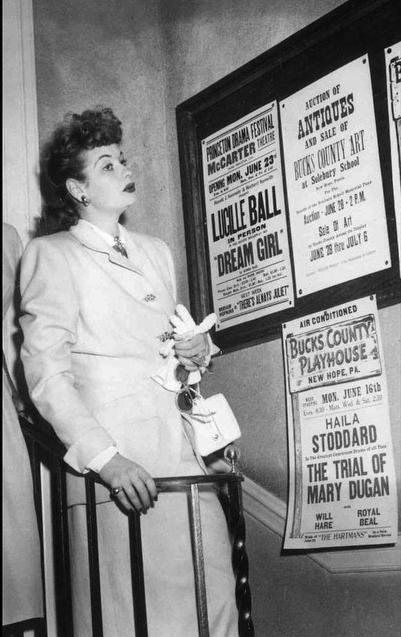
On this date in 1947, Lucille Ball opened in DREAM GIRL, produced at McCarter Theatre, Princeton, New Jersey for the Princeton Festival. The comedy had originally opened on Broadway on December 14, 1945, starring Betty Field and written and directed by Elmer Rice (then married to Ms. Field).
In 1937, Lucille Ball had performed on the McCarter Stage in the play HEY DIDDLE DIDDLE opposite Conway Tearle. The play launched a short tour headed to Broadway, but Tearle’s illness forced it to close in Washington DC, postponing Lucille’s Broadway debut. That would have to wait until 1960′s Wildcat.

Lucille Ball was the Queen of Comedy long before television. In this DREAM GIRL program bio, she continues the fib that she was born in Butte, Montana, finding it more exotic than Jamestown, NY.
Ball played the role of Georgina Allerton, a daydreaming bookshop owner. Subsequently, she toured the show, playing Boston, Detroit, Toronto, San Francisco, Oakland, Brooklyn, and the Bronx.
SYNOPSIS ~ Twenty-two year-old debutante Georgina is the owner of a small unsuccessful bookstore. She also writes novels. She has an overactive imagination and regularly escapes reality by means of her romantic daydreams about three men in her life, which are acted out on stage. The play's time span covers a single day of Georgina's life, during which several successive extravagant and often comic daydreams are portrayed.

The play’s fantasy sequences seemed tailor-made for Ball’s style and comic wit. In a way, Georgina was a prelude to the “Lucy” character on TV, who is dreaming her way out of her suburban life - and sometimes succeeding. In the play, Georgina’s imagination takes her to:
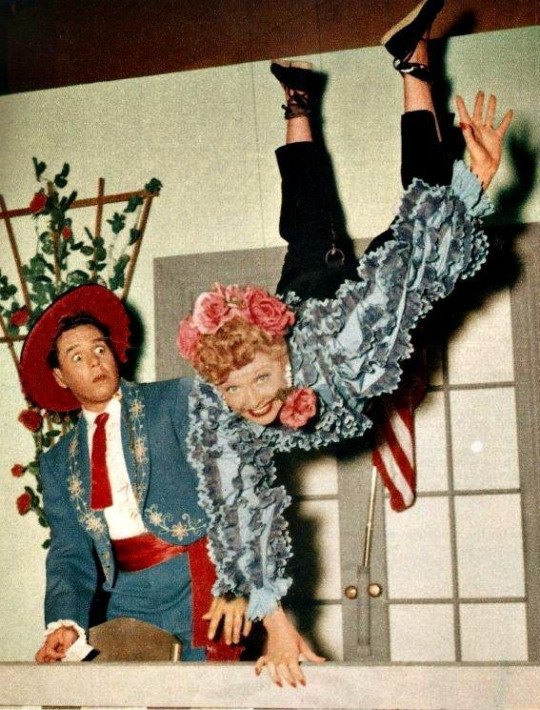
A balcony in Mexico...

The maternity ward of a hospital...
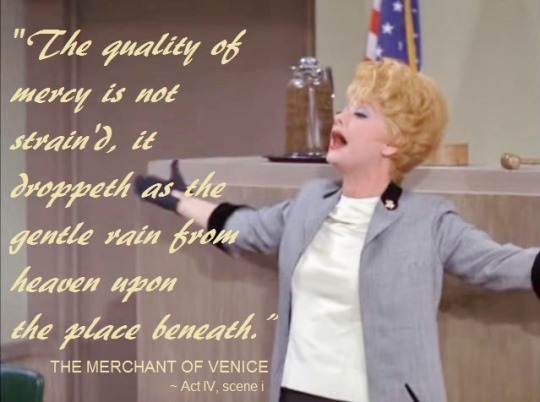
A stage where she plays Shakespeare’s Portia

A street where she is a ‘woman of the night’ in a scarlet red dress.


On two notable occasions, Lucy Ricardo’s fantasy or dream life manifested itself on our TV screens. In “Ricky’s Old Girlfriend” (ILL S3;E12) Lucy dreams of what her life would be like if Ricky left her to go on tour with his former partner, sexy Carlotta Romero.
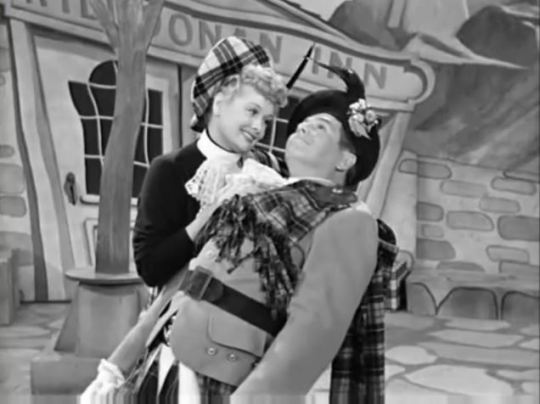
In “Lucy Goes To Scotland” (ILL S5;E17) Lucy dreams of visiting her ancestral home in Scotland while visiting London. Having just come from seeing a West End Musical, she dreams in the musical comedy format!
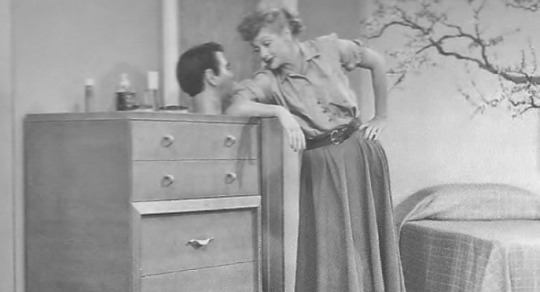
In “Lucy and the Dummy” (ILL S5;E3), after MGM offers Lucy a contract, she imagines fame and fortune but is fully awake. Lucille Ball pantomimes the joys and sorrows of stardom while a Theremin gives the sequence a dream-like, surreal quality. Lucy Ricardo is most like DREAM GIRL’s Georgina in this short reverie.

In “Lucy and the Monsters” (TLS S3;E18), Lucy Carmichael has a nightmare after watching a scary horror movie. The dream takes her and Viv to a haunted house where they encounter a variety of typical movie monsters and then turn into witches themselves - all before waking up.
DREAM GIRL CAST & CREW
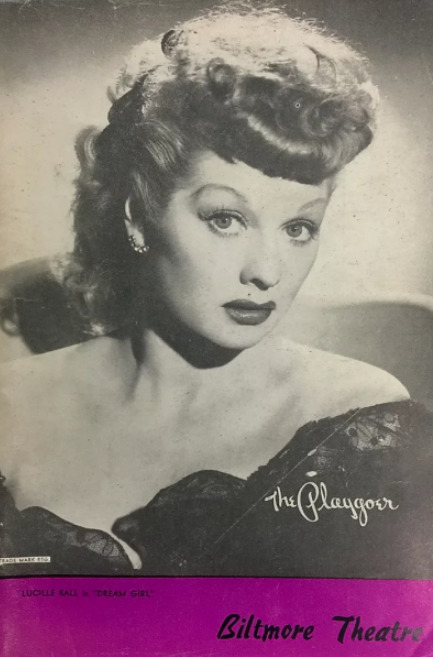
Herbert Kenwith (Producer) later directed 14 episodes of “Here’s Lucy” between 1969 and 1970. Dede Ball warned Kenwith that her daughter was indeed the bitch everyone said she was. Lucille snapped back: “I am not! Only when I’m working.”
Jack Benny (to Herbert Kenwith, about Lucy): "Herbert, you ought to call a psychiatrist for her."
Jus Addiss (Director) was the life partner of DREAM GIRL actor Hayden Rorke. Barbara Eden (who, like Rorke, also guest-starred on “I Love Lucy”) later remembered that Addiss and Rorke were “unabashedly gay” and often invited the “I Dream of Jeannie” cast over for parties.
Jo Mielziner (Settings) had also done the scenery for the Broadway premiere of DREAM GIRL in 1945. From 1949 to 1970 Mielziner won 9 Tony Awards. His designs were adapted by Richard Burns for the tour starring Ball.

The play co-starred Scott McKay as the imaginative writer. McKay played the role of Wilbur in the 1958 pilot for TV’s “Mr. Ed” but was replaced on the series by Alan Young.

Hayden Rorke, best known as Dr. Bellows in “I Dream of Jeannie”, was also in the cast. Lucy later employed him to play the Ricardo’s new neighbor, whom she suspects to be a spy, on “I Love Lucy.” He later returned to play a judge on a 1971 episode of “Here’s Lucy.”
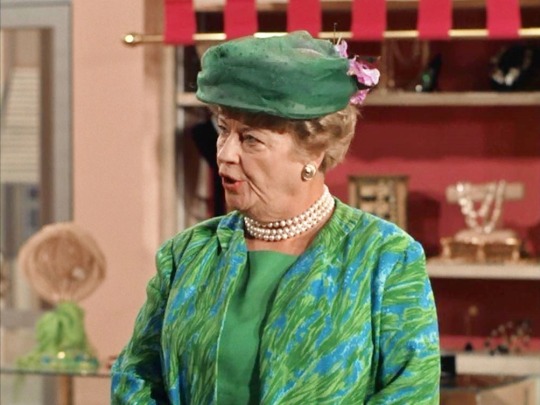
Barbara Morrison was an English-born actress who came to Hollywood in the late 1940s. She did two episodes of “The Lucy Show” and three episodes of “Here’s Lucy.”
Lela Bliss went on to play Mrs. Shellhammer in the 1947 film Miracle on 34th Street, which also starred William Frawley.
Andrew Duggan later did an episode of Desilu’s TV series “The Greatest Show on Earth” (1964). He is best remembered as the voice of the Father in Disney’s theme park attraction The Carousel of Progress.
Phil Arthur appeared on Broadway from 1948 to 1952, his last play with Henry Fonda (Lucy’s one-time boyfriend) and Frances Baviar (Aunt Bee on “The Andy Griffith Show”). He began on television in 1949 and his last job on the small screen was as a background player on “Perry Mason” from 1961 to 1966.
Dorothy Elder began doing television in 1950, but her career only lasted until 1955, as a regular on “True Romances”.

Alan Hewitt was a veteran of sixteen Broadway shows, including the original production of Death of a Salesman (1949) and Call Me Madam starring Ethel Merman (1950). From 1964 to 1966 he played Detective Brennan on “My Favorite Martian.” In 1964, he appeared on an episode of “The Lucy Show.”
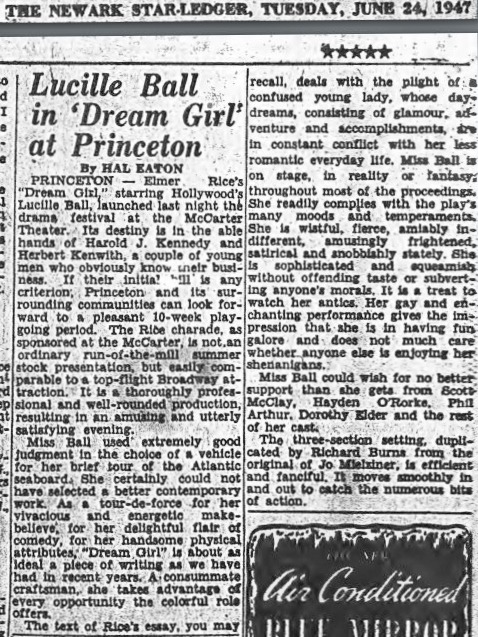
The Newark Star-Ledger review of DREAM GIRL, June 24, 1947. [Thanks to Eric C. Schwarz, research librarian extraordinaire, for the review.]
POST PRINCETON!
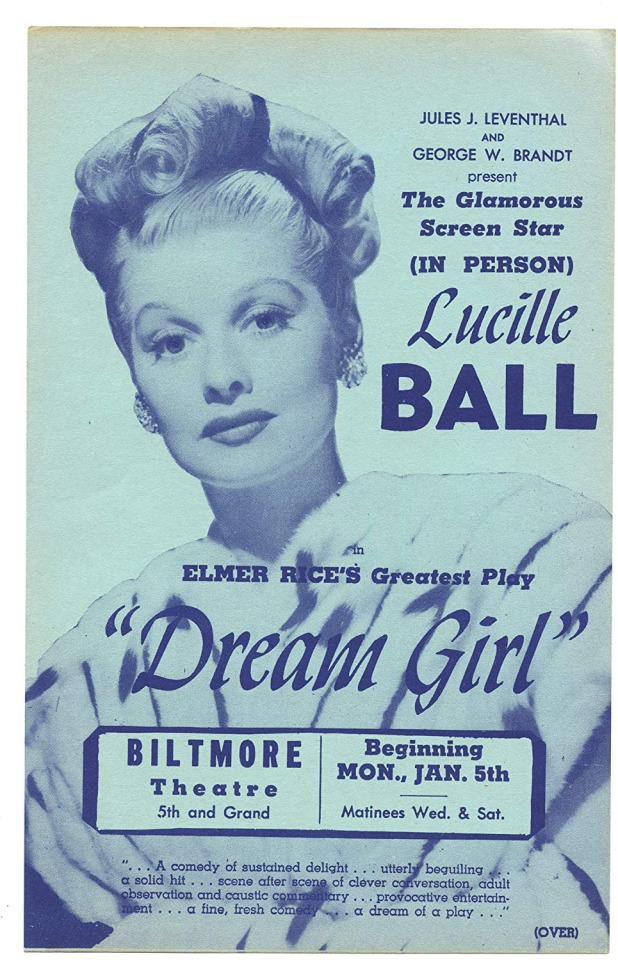
In January 1948, Lucille got the opportunity to recreate the role in Los Angeles, but fell ill with a virus shortly after it opened and the show closed prematurely. Because Ball was known for her film roles, promotion often said that she was appearing “Live In Person” - which seems obvious in a live theatre production!


Handbill for the Los Angeles production that was cut short by Ball’s illness. Lela Bliss took over for Barbara Morrison.



Souvenir program from the Brooklyn engagement at Brandt’s Flatbush Theatre in July 1947. It includes an excerpt from a write-up by Hall Barnell for Actors Cues about the rehearsal he attended at Malin Studios and a sketch of Ball from that day.

Detroit Music Hall - signed program.

Boston Production at the historic Shubert Theatre - signed program.
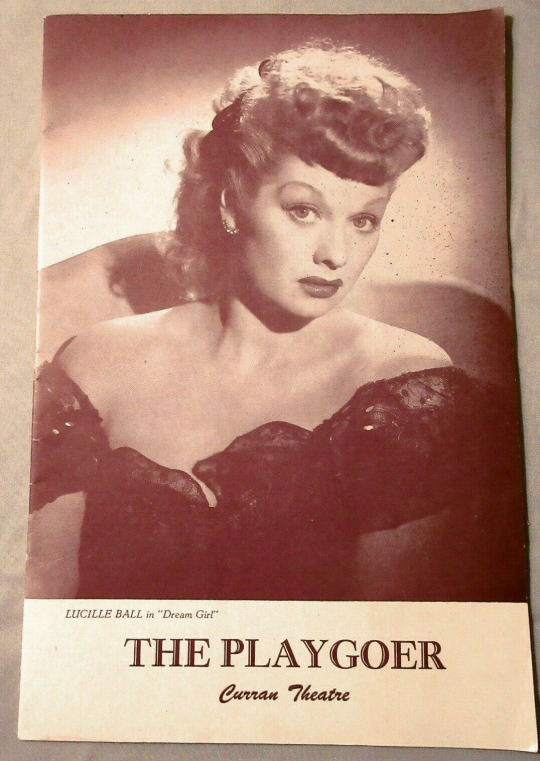
San Francisco production at the Curran Theatre.

During this San Francisco engagement, Ball’s husband was not far away! Five blocks, to be exact. It is likely that Lucy and Desi stayed at the Palace Hotel while she was performing at the Curran. It is also likely that Desi’s performances were in lieu of a hotel bill for the couple!
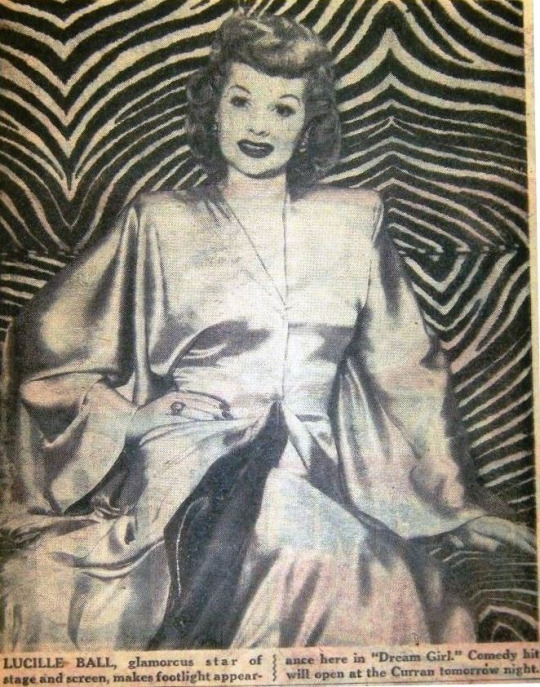
"I have seen other productions of this play, but the only actress whose performance really delighted me was Lucille Ball. She lacked… tender wistfulness, but her vivid personality and expert timing kept the play bright and alive." ~ Edgar Rice, Playwright
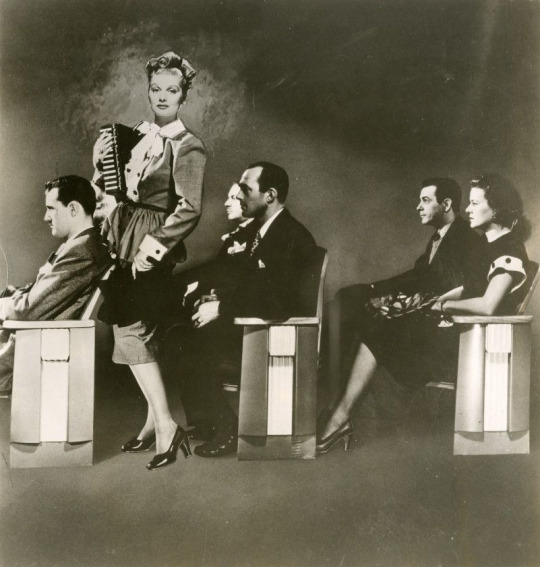
It is pretty clear that this photo was an early version of photo shop. Although it was created during the time of the play, it is quite obviously a manipulated photo.

In August 1947, the show had finally reached what was known as “the subway circuit” - a group of New York City borough theatres that were not considered Broadway. Meanwhile, in Princeton, the summer season continued with yet another show produced by Kenwith and Kennedy, “Horace”. The Billboard review of August 30 was of the opinion that Lucille Ball was simply playing Lucille Ball, and that audiences were okay with that.

This sterling silver cigarette case was a gift to Lucy from the DREAM GIRL company and is engraved on the front: "With Grateful appreciation TO OUR 'DREAM GIRL' December 1947." The lid has the engraved signatures of the company, 17 in all, including actors Scott McKay, Guy Standing, and Andy Duggan. The item came up for auction after the death of Gary Morton.

While Lucy and the DREAM GIRL company were touring, they knew that a film adaption had been made and was awaiting release. It starred Betty Hutton and MacDonald Carey, but did not open to the public till later in 1948. Lucille Ball and Desi Arnaz took a chance on Hutton in 1959, giving her a CBS sitcom “The Betty Hutton Show” which ended after 30 episodes.

In 1955, while Lucille Ball was busy with “I Love Lucy,” NBC made DREAM GIRL into a TV film starring Vivian Blaine. It featured “Lucy” character actors Hal March and Ida Moore.

Ten years later, it was turned into a Broadway musical named Skyscraper, with the play adapted by Peter Stone (”1776″) and starred Julie Harris in her first musical. It earned five Tony nominations. Charles Nelson Reilly guest-starred on “Here’s Lucy” in 1970. Peter Marshall played Lucy’s brother-in-law Hughie on “The Lucy Show” in 1963. Choreographer Michael Kidd also did the dances for Wildcat starring Lucille Ball in 1960.
#Dream Girl#Lucille Ball#Edgar Rice#McCarter Theatre#Barbara Morrison#Jus Addiss#I Love Lucy#Skyscraper#Julie Harris#Vivian Blaine#Betty Hutton#Hayden Rorke
8 notes
·
View notes
Text
Heather Cox Richardson
May 6, 2020 (Wednesday)
What a difference a day makes. Yesterday, Trump was talking about disbanding his coronavirus task force because it had outlived its usefulness and the administration was going to go full speed ahead on rebuilding the economy; today, Time magazine issued this week’s cover: an “OPEN” sign with the N ripped off and put in front of the other letters to spell “NOPE.” The administration’s attempt to pivot from a focus on the botched response to the virus toward a triumphant story of the economy has foundered as reality has caught up with Trump’s cheery narrative.
Yesterday we learned that Rick Bright, the scientist who directed the Biomedical Advanced Research and Development Authority (BARDA), the federal agency charged with developing a vaccine for this coronavirus, has filed a whistleblower complaint. The complaint alleges he was demoted for refusing to spend his agency's money on developing hydroxychloroquine, the anti-malarial drug the administration was promoting for use against Covid-19. But the complaint goes on to charge that the administration pressured him “to ignore expert recommendations and instead to award lucrative contracts based on political connections and cronyism.”
In a very detailed 63-page report, Bright claims that he warned the leadership at Health and Human Services about the coronavirus on January 10, but was first ignored and then ostracized for his insistence that action to prepare for an epidemic was crucial. He says the everyone in the administration except trade advisor Peter Navarro simply refused to take his warnings seriously. Throughout February, Bright peppered administration officials with memos, begging them to secure medical equipment to prepare for the epidemic. Finally, they lost patience with him in March, when he refused to back hydroxychloroquine when the president was touting it as a possible cure for Covid.
Bright told a reporter about the dangers of the drug, and days later was removed from the directorship of BARDA to a post at the National Institutes of Health, because political appointees Alex Azar, the head of HHS, and Dr. Robert Kadlec, Bright’s immediate boss, suspected him of being a source for the article. Bright claims to have been retaliated against for his role as a whistleblower, and is demanding his old job back.
Bright’s whistleblower report was only one of two that offered a window into the administration’s fumbling of the epidemic. We learned that on April 8, a volunteer on Jared Kushner’s coronavirus task force, filed a whistleblower complaint with the House Oversight Committee. Kushner's group took the place of established channels staffed by experts in order to coordinate a private sector effort to find the medical supplies America needed. The complaint, supported by anonymous individuals in the government, says that the people working with Kushner were young volunteers from consulting and private equity firms with no significant experience in health care, procurement, or supply-chain operations, and had no knowledge of relevant laws or regulations. They were ill equipped to do their jobs, and were also ordered to pay particular attention to tips from “VIPs,” including conservative journalists like Brian Kilmeade and Jeanine Pirro, as they searched for medical equipment.
Today, Politico published a story based on audio tapes leaked from three conference calls between HHS and Federal Emergency Management Agency officials and federal officials around the country fielding calls from governors trying to find medical equipment. The calls highlight that as Trump was saying the nation had plenty of equipment, his officials were scrambling to try to provide it. The leaked tapes also show officials privately acknowledging that reopening the states would lead to a higher rate of coronavirus infections.
In an interview with ABC News yesterday, Trump himself admitted the reopening of states for business could cause people to die. At a briefing, when reporter Jim Acosta asked why it was important to end social distancing right now, Trump told reporters "I'm viewing our great citizens of this country to a certain extent and to a large extent as warriors. They're warriors. We can't keep our country closed. We have to open our country ... Will some people be badly affected? Yes."
But Trump didn’t offer much to provide confidence that the government was on top of the ongoing coronavirus response. In the ABC News interview, when Trump blamed President Barack Obama for leaving the “cupboard” of the Strategic National Stockpile “bare” of medical supplies when he left office, anchor David Muir asked him what he had done to restock it in the three years he’s been in office. The question appeared to catch the president, who is accustomed to a friendly audience on the Fox News Channel, off guard. “Well, I'll be honest,” he said. “I have a lot of things going on. We had a lot of people that refused to allow the country to be successful. They wasted a lot of time on Russia, Russia, Russia. That turned out to be a total hoax. Then they did Ukraine, Ukraine and that was a total hoax, then they impeached the president of the United States for absolutely no reason.”
A Washington Post article by Dr. Zack Cooper, associate professor at the Yale School of Public Health and Yale’s Economics Department, says that we do, in fact, have the ability to test at the rate of 20 million tests a day, which is what experts say we need in order to reopen the economy safely. But the rub is that it would cost about $250 billion, and there has not, so far, been sufficient political will to spend that kind of money on testing, especially when those most affected by the reopening of states have been poor Americans and workers who are disproportionately people of color. A Rockefeller Foundation committee on reopening the economy has published a report on how to do so safely; Cooper was a member of the committee.
But for all these events undercutting Trump’s push to reopen the economy, what got under his skin most dramatically was an advertisement released Monday by the Lincoln Group entitled “Mourning in America.” This one-minute spot plays on President Ronald Reagan’s famous “Morning In America” reelection campaign ad, showing Trump’s term as the opposite of the rosy vision people associated with Reagan. “There’s mourning in America,” the voice in the ad intones over shots of Covid-stricken patients and folks in unemployment lines in masks, “and under the leadership of Donald Trump, our country is weaker, and sicker, and poorer. And now, Americans are asking, ‘If we have another four years like this, will there even be an America?”
It took Trump four tweets to express his fury adequately, calling Lincoln Project founder George Conway a “deranged loser.” Ten hours later, he was still fuming, and ranted about the Lincoln Project to reporters for two minutes on the tarmac at Joint Base Andrews. This gave Conway the opening to hit him again in an op-ed in the Washington Post today. The article used Trump’s behavior to illustrate Conway’s usual concerns about Trump’s fitness for office, but it began with a new focus on the coronavirus: “Americans died from Covid-19 at the rate of about one every 42 seconds during the past month. That ought to keep any president awake at night.”
8 notes
·
View notes
Link
Some people who pass on clear the way for progress. This is one of those people.
Excerpt from this New York Times story:
S. Fred Singer, a physicist whose efforts to refute established climate science earned him the enmity of experts, died on April 6 at a nursing facility in Rockville, Md. He was 95.
Even as evidence of the human causes of climate change and its risks to the planet coalesced into a scientific certainty, Dr. Singer argued that the threat of climate change was overblown, that efforts to blunt its effects would cause grievous economic damage, and that the effects of global warming would be largely beneficial.
“Not only was Fred among the first atmospheric experts to publicly question the validity of climate models, but as it became more and more politically incorrect to criticize the models, Fred was unmoved,” said Steven J. Milloy, a climate-change denialist who served on President Trump’s transition team for the Environmental Protection Agency. “He doubled and tripled down on substantive criticism of the models, putting his scientific view ahead of the risks to his stellar career and reputation.”
Dr. Singer was a focus of the book “Merchants of Doubt” (2010), which examined how tobacco and other industries promoted a small group of scientists who worked to muddy the truth on climate change and other environmental risks, including secondhand smoke, asbestos and acid rain. He was one of those, the book’s authors, Naomi Oreskes and Erik M. Conway, wrote, who “used their scientific credentials to present themselves as authorities” and “used their authority to try to discredit any science they didn’t like.”
With the coming of the Trump administration, climate contrarians were once again in demand, and Dr. Singer was considered “the most senior of Mr. Trump’s experts on climate change,” Peter Ferrara, a senior fellow at Heartland, wrote last year in an essay in The Washington Times.
10 notes
·
View notes
Text
Skip to main content
DONATE

Mother Jones readers and reporters are rising to the challenge every day. If you can, please consider supporting essential journalism during this crisis.
Donate
CORONAVIRUS
16 MINS AGO
Will Trump and His Enablers Ever Face Accountability for the Coronavirus Massacre?
The Iraq War is not a good precedent.

DAVID CORN
Washington, DC, Bureau Chief
Bio | Follow

Mother Jones illustration; Oliver Contreras/CNP/Zuma; Getty
For indispensable reporting on the coronavirus crisis and more, subscribe to Mother Jones' newsletters.
They misrepresented the threat. They disregarded experts. They did not prepare adequately. And thousands of Americans died.
And they got away with it.
The implementers, cheerleaders, and enablers of the catastrophic Iraq War were never punished for their actions. It’s not too early to wonder if Donald Trump and those who joined him in discounting and downplaying the coronavirus threat or who were part of his lethal mismanagement of the crisis or who echoed his false statements and absurd claims of winning will ever pay a price for conduct that has led to a current death toll of 12,000, which could end up a magnitude of order greater.

Advertise with Mother Jones
The Iraq War and occupation, a strategic blunder of historic proportions that was mismanaged from the start, caused the deaths of almost 5,000 US service members and about 200,000 Iraqi civilians. And it was all for naught. There was no WMD threat to neutralize. The invasion did not remake the region and spread democracy. It wreaked chaos and violent instability that continue to plague Iraq and the world.
Yet the architects and engineers of this epic disaster never faced a reckoning. George W. Bush and Dick Cheney were reelected, and after their second term was done, they were rewarded with lucrative book contracts, as was former Defense Secretary Donald Rumsfeld. Paul Wolfowitz, the assistant secretary of defense, became the president of the World Bank. Bush went on to become a pal of Michelle Obama. Ari Fleischer, Bush’s press secretary, was hired as a media consultant for the NFL. National security adviser Condoleezza Rice returned to academia and public speaking and served on the college football playoff selection committee. Columnists who championed the war—Thomas Friedman, David Brooks, the editorial writers of the Washington Post and the Wall Street Journal—kept their prestigious and well-paying jobs. The dogs of war who howled on Fox News and within the conservative media were not punished. Sean Hannity, a month before the 2003 invasion, declared, “We’re going to go in and we’re going to liberate this country in a few weeks and it’s going to be over very quickly…We’re going to find all of the weapons of mass destruction.” Today, Hannity is the biggest, highest-paid loudmouth at Fox. Democratic legislators who voted in 2002 to provide Bush the leeway to launch the war were not banished. Two won their party’s presidential nomination (John Kerry and Hillary Clinton), and a third (Joe Biden) is on his way to do the same.
There has never been true accountability for this massive screwup that cost thousands of Americans their lives.
Will that happen again?
It is undeniable (for any reality-based observer) that Trump botched the response to the coronavirus pandemic. A recent Washington Post article depicted this tragedy of incompetence in painful detail. And Twitter is loaded with videos showing Trump repeatedly uttering false statements, discounting the coronavirus threat, and claiming the virus was contained. For weeks, he conveyed the message that there was nothing to worry about. He was late to accept the need for social distancing and did not encourage governors to implement necessary shutdowns. He claimed a national testing system was about to start. It never happened, and his administration has failed to develop wide-scale testing. He did not move quickly to prepare health care workers with needed personal protective equipment and ventilators. He essentially told governors they were on their own.
SIGN UP FOR OUR NEWSLETTERS
Subscribe and we'll send Mother Jones straight to your inbox.
EmailSign Up
The most recent of all the revelations showcasing Trump’s ineptitude was especially stark. In late January, White House aide Peter Navarro sent Trump a memo noting, “There is an increasing probability of a full-blown COVID-19 pandemic that could infect as many as 100 million Americans, with a loss of life of as many as 1-2 million souls.” The warning never registered with Trump.
There has been an endless series of profound errors committed by Trump and his administration prior to and during this horrific crisis. Then–national security adviser John Bolton shut down the White House’s global health security office in 2018; the Trump team ignored a pandemic playbook left for it by the Obama administration. And Trump, the malignant narcissist, has, to no one’s surprise, explicitly rejected all responsibility for the glaring missteps and deadly miscalculations. Instead, he has boasted about the ratings for his daily press briefings.
Trump and adoring sidekick Mike Pence will face a moment of judgment in November, when voters will render a verdict. But what of all the others who helped make this moment of mass-death possible? The Dear Leader crowd that supports Trump no matter what has echoed, protected, defended, and bolstered him as he has guided the nation into a nightmare of economic calamity and rampant death. You know who they are. (If not, watch this.) White House advisers Kellyanne Conway and Larry Kudlow—who each will likely look for remunerative gigs after their time with Trump—both claimed the coronavirus was “contained.” Trump’s newly acquired press secretary, Kayleigh McEnany, proclaimed in February, “We will not see diseases like the coronavirus come here..and isn’t it refreshing when contrasting it with the awful presidency of President Obama.” Rush Limbaugh told his millions of Dittohead listeners that the coronavirus was no worse than the “common cold.” (Should he give back the Medal of Freedom Trump awarded him in February?) Numerous Fox-heads, including Hannity and Laura Ingraham, misled the public, reinforcing Trump’s insistence that the threat was a hoax and discounting the seriousness of this virus. Only Trish Regan was booted by Fox after she derided what she called the “coronavirus impeachment scam.” The others have remained in place.
Then there is the Republican Party. None of its leaders have dared to challenge Trump, as he misrepresented the threat and lied about his administration’s response. Rep. Devin Nunes (R-Calif.) encouraged his constituents to ignore calls for social distancing and to go to restaurants. Rep. Matt Gaetz (R-Fla.) mocked concerns about the virus by wearing a gas mask on the House floor. Senate Majority Leader Mitch McConnell (R-Ky.) and House Republican leader Kevin McCarthy (R-Calif.) never publicly questioned Trump’s multiple blunders, and they continued to lead their party in a cultlike manner of total obeisance to Trump. Many others share the blame. Conservative and right-wing evangelical leaders, including Jerry Falwell Jr. of Liberty University and Matt Schlapp of the American Conservative Union, reinforced the no-big-deal theme that was pushed by Trump’s White House and have considered Trump faultless.

Advertise with Mother Jones
So with thousands of Americans dying in part because of Trump’s feckless and reckless response, who will be held responsible? Rep. Adam Schiff (D-Calif.), who prosecuted the impeachment case against Trump, has proposed creating a coronavirus commission like the 9/11 commission that investigated all the mistakes and misconceptions that preceded that horrible attack. The 9/11 commission produced a detailed and elegantly written report that offered a stunning indictment of the Bush-Cheney administration and the US intelligence community. (Still, Bush and Cheney were reelected.) But one can expect Trump, the Republicans, and their amen choir to rabidly oppose Schiff’s idea (as Bush opposed establishing the 9/11 commission).
American society does not do accountability well. The instigators of the Iraq War did not suffer. Nor did the bankers who crashed the US economy in 2008. We do have elections, and Trump, Pence, and their Republican handmaids will be on the ballot in seven months. But what of the Fox barkers, the conservative movement that has become no more than a promotion vehicle for Trumpjackery, and the entire right-wing noise machine? With their obsessive devotion to Trump, they all have helped pave the way to a national massacre. Will they be able to wash the blood off their hands? Can a large and deplorable slice of the national political media apparatus be judged guilty of murderous culpability and locked up (metaphorically)?
“Nations should have memories,” Frederick Douglass once said. But Gore Vidal frequently referred to the “United States of Amnesia.” And the past is not a good prelude for accountability. Too often the culprits who contributed to death and destruction end up skating along, even experiencing personal benefit. At this moment, the priority for the nation is to rise above Trump’s incompetence and contend with a killer virus that is robbing us of our friends, neighbors, and loved ones and causing severe economic and societal dislocation. But there ought to come a time for a tallying: who did what when, during a life-and-death national crisis. And it is not too early to be collecting receipts. None of this should be forgotten.
FACT:
Mother Jones was founded as a nonprofit in 1976 because we knew corporations and the wealthy wouldn't fund the type of hard-hitting journalism we set out to do.
Today, reader support makes up about two-thirds of our budget, allows us to dig deep on stories that matter, and lets us keep our reporting free for everyone. If you value what you get from Mother Jones, please join us with a tax-deductible donation today so we can keep on doing the type of journalism 2020 demands.
Donate
More about:CoronavirusDonald Trump
RELATED

“Like a Used Rag That Was Thrown in the Trash”: Coronavirus Comes for Domestic Workers
FERNANDA ECHAVARRI

The Acting Secretary of the Navy Just Resigned
DAN SPINELLI

Trump Declares War on Watchdogs
DAN FRIEDMAN

How Republicans Exploited the Coronavirus to Steal a Wisconsin Election
ARI BERMAN

Advertise with Mother Jones
WE RECOMMEND

WhatsApp Takes Steps That Could Slow the Spread of Coronavirus Misinformation
SINDUJA RANGARAJAN

Here’s Where the Demand for Guns Is Soaring
JULIA LURIE

Exclusive: Elizabeth Warren Has a Plan to Protect Your Right to Vote From the Coronavirus
ARI BERMAN

What Do the Cast of “Hamilton” and Jim Halpert From “The Office” Have in Common?
DANIEL KING

Advertise with Mother Jones
LATEST

Trump Fired a Government Watchdog for Doing His Job. Congress Isn’t Stopping Him.
DAN FRIEDMAN

My Father Was the First Federal Prisoner to Die of COVID-19. He’d Been Trying to Get Out for Years.
CHRISTOPHER WALKER AS TOLD TO SETH FREED WESSLER

It’s Hardly Shocking the Navy Fired a Commander for Warning of Coronavirus Threat. It’s Part of a Pattern.
T. CHRISTIAN MILLER AND MEGAN ROSE

The Elizabeth Warren of This Recession Is…An Elizabeth Warren Staffer
KARA VOGHT

Advertise with Mother Jones
We have a new comment system! We are now using Coral, from Vox Media, for comments on all new articles. We'd love your feedback.
VIEW COMMENTS
Independent. In print. In your mailbox.
Inexpensive, too! Subscribe today and get a full year of Mother Jones for just $12.
Subscribe
 April 2020

Smart. Fearless. Audio.
It's us but for your ears. Listen on Apple Podcasts.
Subscribe »
Looking for news you can trust?
Subscribe to our free newsletters.
EmailSign Up
ABOUT
Our Staff
Financials
Jobs
Events
Contact Us
SUPPORT
Ways to Give
Advertise With Us
Store
SUBSCRIBE
Magazine Subscriptions
Give a Gift Subscription
Email Newsletters
Podcasts
Customer Service
Copyright © 2020 Mother Jones and the Foundation for National Progress. All Rights Reserved.
Terms of Service Privacy Policy


1 note
·
View note
Text
For anyone who doesn’t have the time or inclination to read the “Mueller report”...
I noted some highlights from Volume I that you can read in 5 minutes. I couldn’t help myself. 😆
*”The Russian government interfered in the 2016 presidential election in sweeping and systematic fashion.”
*The counter-intelligence investigation was opened because Papadopolous told a foreign diplomat that the Russian government could assist Trump by releasing damaging info on Clinton.
*The Trump campaign “welcomed the potential damage” resulting from Russia’s “information warfare” and “active measures.”
*The IRA (Internet Research Agency), based in Russia and funded by “Putin’s Chef” Yevgeniy Prigozhin, launched an information warfare campaign to undermine the US electoral system.
*Trump, his sons, and many of his minions like Flynn and Kellyanne Conway promoted Russian generated content alleging voter fraud and other Russian propaganda lies.
*An estimated 126 million people saw posts made by the Russians to influence the election.
*The Russians “organized and promoted” dozens of “political rallies inside the US while posing as US grassroots activists,” going so far as to communicate with Trump campaign members to help coordinate the rallies.
*The Russian military hacked the computers and email accounts of hundreds of Clinton campaign employees, advisors, and volunteers, the DNC and the DCCC, releasing documents timed to interfere with the election. They implanted malware on their networks. GRU officers captured their passwords, banking information, sensitive personal information, internal communications, etc.
*GRU military units targeted military, political, governmental, and non-governmental entities in the US.
*Russian military GRU officers targeted and hacked computers belonging to US state and local entities, Secretaries of State, state boards of elections, county governments, and private technology firms that manufacture and administer “election-related hardware and software, such as voter registration software and electronic polling stations. The GRU continued to target these victims through the elections in November 2016.”
*In just one example, the GRU gained access to info on “millions of registered Illinois voters.”
*Russian government officials and prominent businessmen made a concerted effort during the campaign and post-election transition period to make inroads into the Trump camp.
<Kushner just blew that all off as a few FaceBook posts.>
*Trump fired Comey and freaked when the Special Counsel was appointed, saying it was the end of his presidency. He tried repeatedly to get Sessions to “unrecuse” and to curtail the investigation.
*Trump’s cohorts lied to Congress and the SCO, destroyed evidence, and in some cases refused to be interviewed to avoid accountability.
*Amidst many redacted paragraphs, a few words indicate that while Trump and Gates were driving to La Guardia, Trump told Gates that more releases of Clinton emails were forthcoming.
*Trump continued to express frustration that the Clinton emails had not been found. The Trump Campaign planned an entire strategy around their release by WikiLeaks.
*Harm to Ongoing Matter* Looks like Corsi is in very hot “ongoing matter” water, which is redacted. Unless Barr can still save him.
*Podesta e-mails stolen by the GRU are released by WikiLeaks less than an hour after we all watch the video of Trump say disgusting things about women - “I moved on her like a bitch” and if you’re a star you can do anything you want like “grab them by the p*ssy.”
*Trump Jr “colluded” with WikiLeaks by messaging with them and tweeting links they requested he share. However, they did not conclude it was a “coordinated effort” with Russia to disseminate the e-mails.
*Trump repeatedly asked people affiliated with his campaign to find the “deleted Clinton emails.” Flynn took it to heart and sent people looking, like Peter Smith, the man whose suicide note read “NO FOUL PLAY WHATSOEVER.” Smith claimed he was in contact with Russian hackers and was coordinating his efforts with Trump campaign members Flynn, Sam Clovis, Bannon, and Kellyanne Conway. The SCO could only verify he communicated with Flynn and Clovis for certain.
*Again, because it’s so much worse than Watergate because it involves a hostile foreign adversary directing a concerted attack on our country, TRUMP DIRECTED his campaign people to find the emails he assumed to have been hacked by the Russian military so he could use them to harm his political rival.
*There are a gazillion (by my count, only 101 per Business Insider) “links” between the Trump campaign and those with ties to the Russian government, but the Office could not prove with the info available to them that it rose to the level of a chargeable criminal conspiracy. Again - none of the players “remember” or “recall” anything damning, or they refused to be interviewed or destroyed evidence. This is an incredibly high bar of proof for a narrowly defined crime, so carry on being traitors.
*Trump Jr. seeks documents and info to incriminate Clinton via Goldstone, who says the Crown Prosecutor of Russia is offering them, prompting the “Trump Tower Meeting.”
*On page 187 there’s a paragraph that I find pretty gross. They are letting the Trump Tower meeting participants like Jr. (who refused to be interviewed) and Kushner off in part because they may have been ignorant of campaign finance law. Also, they can’t prove how much the damaging info the Russians claimed to have was worth monetarily, so they get another pass. President Trump and Jr. went to great lengths to cover up this meeting, which any reasonable observer knows is because they KNEW it was ethically wrong, and that it might also be illegal.
*Trump’s written answers to Mueller’s questions state he doesn’t remember if he was involved with changing the RNC’s platform stance on armed support for Ukraine.
*Manafort had Gates give Kilimnik (ties to Russian Intelligence) Trump Campaign updates and polling data, which per Manafort’s own attorney’s admission in Manafort’s trial was “very detailed” and “focused.” Many of Manafort’s shady dealings were covered up by using encrypted applications.
*Russian and Ukrainian oligarchs fully intended to use Manafort to get Trump to support their plan to control eastern Ukraine.
*Pages and pages of shady stuff about Russians, Erik Prince, Nader, the UAE, a chess tournament, the Seychelles, Libya, etc.
*Bannon and Prince’s phones had no text messages on them prior to March 2017, and neither one of them knows why. What a mystery. Provider records show they exchanged dozens of messages.
*Kushner asks Kislyak if they can communicate “using secure facilities at the Russian Embassy” so that, per Kislyak’s suggestion, Russian generals can talk to the Trump transition team to brief them on Syria. Kislyak says no to the Russian Embassy idea.
*Kushner meets with Gorkov, the head of the Russian-government-owned and US sanctioned VEB bank. Kushner says the meeting was “diplomatic.” VEB bank’s public statement says they met to discuss “business.” Mueller here reminds us that Kushner was about to owe a ton of money on 666 5th Ave.
*The Trump Transition team attempted to undermine the Obama administration regarding a United Nations resolution calling for Israel to “cease settlement activities in Palestinian territory.” There was media speculation that the US would not oppose it. Multiple Trump team members, including Michael Flynn and President-elect Trump, communicated with foreign governments such as Russia and Egypt to undermine or delay the resolution, and thereby the current US administration. It passed 14-0 with the US abstaining.
*In sum, despite all the many contacts between the Trump campaign and Russians, the Trump campaign was receptive to their offers of help only sometimes and it did not rise to the level of conspiring with the Russian government’s election interference campaign. It would be difficult to prove they “willfully violated the law.” Their actions may not be sufficient to sustain criminal charges under FARA or criminal conspiracy law, but several of them blatantly lied and obstructed justice anyway and were charged accordingly, like Papadopolous and Flynn.
*Insufficient evidence to charge Jeff Sessions with perjury because his cagey answers and faulty memories (colloquially known as “lies”) were plausible in the context of the questions.
*Some other characters not charged with perjury/making false statements because of evidentiary hurdles to prove falsity, others because the witnesses were ultimately truthful, and others because of “considerations of culpability, deterrence, and resource-preservation.”
- Elizabeth Renfrow Madison
65 notes
·
View notes
Text
Spider-Man: Going Big #1 (Story 3) Thoughts

...er....mixed feelings.
Okay so I feel your enjoyment and appreciation of this story depends upon how you feel about Larsen.
I don’t like him.
I don’t like most of his art.
I don’t like most of his writing.
I don’t like him much as a person.
And so consequently this story being written by him celebrating his own return rubs me the wrong way.
It’s not even like his contributions to Spider-Man lore are all that significant. His biggest claims to fame was being the guy who gave Venom bigger teeth and a tongue which other people drew better, co-creating Cletus Kasady (not even Carnage, Kasady) and being the guy who followed up McFarlane.
Larsen of course has a fanbase, a significant one at that and is one of the original 90s superstar IMAGE artists so it makes sense why the issue be promoted on the basis of his work.
But...you can see why they made his story a back up and Conway’s the main story.
Namely because there isn’t much story here.
It’s not...awful exactly. Spidey action+Spidey banter+Spidey intelligence is great to see and depicting him as resourceful and prepared but making one mistake is a very human Spidey moment.
It’s just that not much is happening here.
The MJ moment also irked me. I’ve said before it’d be healthier if MJ wasn’t just 100% supportive and understanding all the time, she should be allowed at times to get pissed off and frustrated. I think right now the reason she is written as so loving and understanding is because we had such an extreme in the opposite direction for so long.
That being said Larsen depicting her that way has some baggage to it. First of all he has her say Peter delivers one crushing disappointment after another. A playful jab not to be taken seriously?
You can interpret it that way for sure but I doubt Larsen intended it that way. And my rationale for that leads into the second problem, Larsen has been on record as disdainful of the marriage and of MJ’s jobs as a model.
So I think he was throwing shade which further makes him unpleasant in my eyes.
Read this if you are a Larsen die hard but otherwise skip it.
BTW...why was this called Going Big in the first place?
P.S. Larsen draws the best rendition of Mary Jane in his career.
#Spider-Man#Peter Parker#Erik Larsen#mjwatsonedit#Mary Jane Watson#Mary Jane Watson Parker#mj watson
4 notes
·
View notes
Note
If you were told to write a spiderman series, with the regular high school/college love triangle shenanigans involving the usual ladies of Peter's life, only with the twist that in the end Spiderman/Black Cat would be the actual couple of the series, how would you go about writing them? Also what do you think the good and bad things about a series focused the ship would be?
(Sorry for the delay. The most recent chapter of Traitor’s Face insisted that every single thing I wrote for it needed to be completely rewritten at one point or another.)
Huh, now this is a new idea. It reminds me of how the 90’s animated series started with Felicia Hardy, no Black Cattiness at all, as the main love interest. And for some reason she was a cheap knock-off of Gwen Stacy for something like four seasons. I can only guess that they came up with the character first, and then stuck a random name on her from the comics.
However, if they *did* start with the idea of using Felicia, I understand how they wound up having to add so much to the character. The first big problem with the concept is that she essentially doesn’t have any character besides being the Black Cat. So anything that tried to make her the winning Love Interest would either need to bring Felicia into Peter’s civilian life and flesh her out as something more than a costumed adventurer/criminal/hero, or make the focus of the stories on his life as Spider-Man. You know, maybe do something like the Ultimate Spider-Man cartoon and make him a pro-hero all the time.
The second big problem is the Black Cat’s weird status with her powers. If she doesn’t have any powers, she’s just a Catwoman knock-off. For a short while she had generic Cat powers, but that’s nothing that’s going to put her on the map. Her ‘true’ power, as far as I’m concerned, is her Bad Luck thing; it plays well on her full theme, it’s fairly unique, and it’s something that can be presented in a dynamic way, with her opponents continually encountering ridiculous bad luck as they try to impede her. But there’s no real origin for those powers, is there? She got them from Kingpin (in a story I haven’t read) and as far as I know the exact method by which he gave her those specific powers isn’t known; it’s incidental to plot point of her going to Kingpin in the first place. So a full, meaningful origin would have to be invented for those powers, too.
The final thing that needs to be created for the Black Cat is a reason to stick around long-term. She dips in and out of the comics because, when she isn’t romantically involved with Spidey, there’s really no reason for her to be in the story. She pursues her own goals, which can take her away from Spidey’s drama.
With all that in mind, here’s a possible scenario I came up with to answer the question.
Set during college years, Felicia and Peter are childhood friends, once being part of a Three Amigos thing with Flash Thompson before Flash became a bully. All three came from messed up histories, with Peter being the orphan raised by his aunt and uncle, Flash having an alcoholic father, and Felicia having something more complicated that we’ll get into. What Peter doesn’t know is that Flash turned against him because Flash fell in love with Felicia, but she had feelings for Peter. Peter never noticed because in high school he was a total nerd who didn’t feel lovable, and after that he was too distracted by Spider-stuff.
Anyway, Felicia’s backstory is that her family was super-poor until her father started working for the Kingpin as a spy, enforcer, and coordinator/boss of Kingpin’s thieves. Their family had to hide that Daddy was involved in organized crime. After Felicia got into college, though, things became more strained, as her father couldn’t deal with all the super-heroes who have been chipping away at Kingpin’s empire, especially that insufferable Spider-Man! But Kingpin has made a deal with an evil scientist (maybe Norman Osborn, maybe the Jackal, maybe even Doc Ock) who has developed a counter for Spider-Man: a 'Bad Luck’ power that’s actually an unconscious psionic defensive ability to alter the immediate future. It’s a direct counter to Spider-Man’s Spider-Sense, which is an unconscious precognitive defensive ability.
For reasons, this can only be given to one person. Perhaps having too many Bad Luck people around compounds the effect? Or maybe Kingpin fears the power’s subtle nature, and doesn’t want to pass it around too much. Perhaps a few other limited people are given the power, but they only come into the story on rare occasions, like when Felicia needs to deal with a Shadow Archetype.
So Felicia becomes the Black Cat, and becomes an apprentice to her father. She battles Spider-Man, but isn’t entirely committed to the idea. She’s a good person, and doesn’t like the Kingpin or the way his empire hurts people. But she’s loyal to her family, and if she doesn’t do something about Spider-Man, her dad will be killed. She’s also juggling her college like, because she wants to eventually get out of being a criminal.
This all gets complicated when Felicia’s Bad Luck ability sets into motion a sequence of events that end with her finding out that Peter is Spider-Man, with Spidey unaware.
So we settle into our storytelling engine, where Spidey encounters some crime or adventure. If it doesn’t involve the Kingpin, then Black Cat helps him out because she wants to protect her buddy Peter. If the Kingpin is involved, Spidey and Black Cat can find themselves on opposite sides; in those cases, Black Cat obviously is trying to hold back against Spidey, and because he can sense this, he holds back against her, too. He even becomes rather taken with her.
This frustrates Felicia to no end, for obvious reasons.
Throw in the complication that, in their civilian lives, Flash is dealing with his family history and trying to be a better person as he goes through college. He tries again with Felicia, who both feels bad for him and is frustrated that Peter is more interested in her alter-ego. And there’s the outgoing Mary Jane Watson who seems interested in Peter, and he in her.
A change in the dynamic can happen if Peter discovers Black Cat’s secret identity. Perhaps he doesn’t realize that she knows who he is, and she doesn’t know that he knows about her in turn, so hilarity ensues as they’re both unaware that they could end all these complications with a very simple conversation.
Another 'end of an era’ switch-up can happen if the Kingpin gets taken down, but not necessarily Felicia’s father with him. I like the idea of replacing Kingpin as the big bad with Norman Osborn, and Osborn discovering Peter’s identity can mess around things. Perhaps Felicia’s father even teams up with Osborn, dragging her into the conflict. The love triangle could be messed up by Harry Osborn getting involved and pursuing Felicia or the Black Cat- or both!
I’m thinking we also need to eventually do something for the Black Costume Saga, so that Flash has the opportunity to become Agent Venom and get involved in the super-heroics that his childhood friends are perpetrating. It would be interesting if Agent Venom is working for SHIELD or somesuch government agency, and both Spider-Man and Black Cat can be wanted felons by that point, so they’re both fighting Flash without realizing it. Bonus points if Flash’s superiors include a corrupt character who is running a criminal sideline.
I’m keeping to the spirit of this idea as a comic book, so I don’t have a definite endgame. Obviously, Peter and Felicia would have to become fully aware of each other’s identities and knowledge. Perhaps Flash’s death is what inspires them to finally try to commit to each other, or else the defeat of a major villain, which might wind up being Felicia’s father as their ultimate enemy. I don’t think I’d have them give up their superheroics afterward, but it probably depends on all the drama and trauma they’ve suffered through at that point. Since the speculative scenario is that I’m writing a real comic book with this storyline, I need to keep my options open for either getting canceled after twelves issues or going over a hundred.
The main appeal of this kind of series, I think, is that the female lead gets to be involved in both the civilian soap opera stuff and the superhero drama. It’s always hard to get the love interest involved with the superheroics, Lois Lane being the exception to prove the rule. In every other case, I loathe it when the Reporter job is used, because it feels so derivative of Lois.
The main weakness of this series, I’m thinking, is that excuses have to be generated to keep Spidey and Black Cat from just talking things through and teaming up. Their relationship needs to remain in a constant state of volatility, although sometimes at a low simmer, and that can become contrived.
Also, as shown by my plans here, the end-ship is going to be telegraphed from the start. I think it’s futile to try to make the Black Cat a dark horse in the romantic race like Mary Jane was, because MJ’s success was an accidental result of many contributing factors, including the transition from Stan Lee to Gerry Conway as the primary Spider-Man writer, and then the promotional mandate that had the newspaper comic strip’s marriage between Peter and MJ forced on the main comic line.
Also, I’m not one for real love triangles in fiction. Done right, it just seems like a good way to alienate at least half the audience at the end, while being done poorly is just going to make the ending obvious anyway. It’s fine to throw in spoilers every now and then, but any romance I write is going to end in a predictable way, and the audience is just there to enjoy the ride.
1 note
·
View note
Text
Amazing Spider-Man: Renew Your Vows #13-15 Thoughts


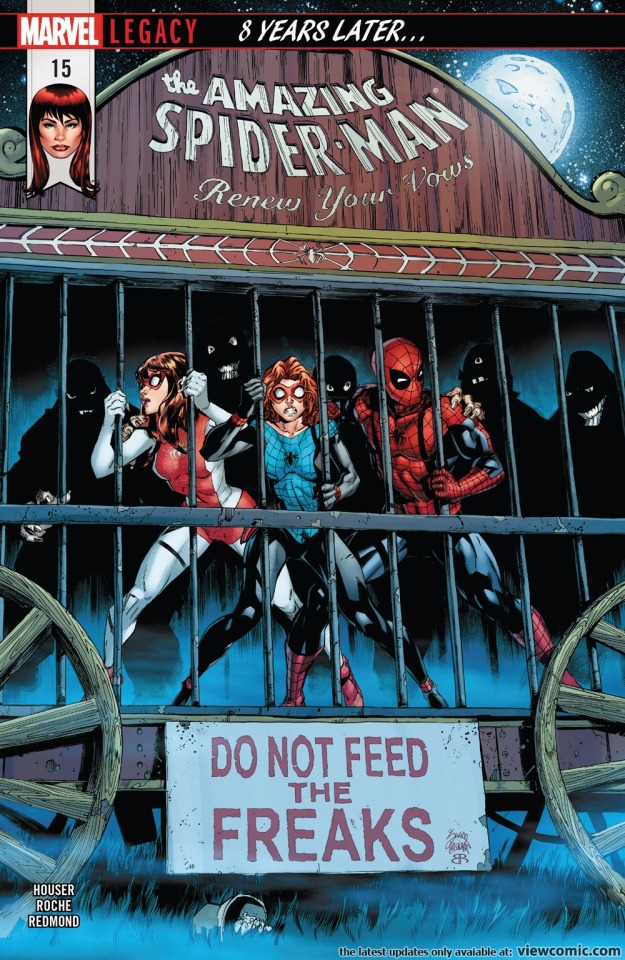
Previous thoughts here.
Yes I know I couldn’t be later to this party but I started this series so I’m going to finish giving my thoughts on it.
I tried very hard to finish Houser’s run on RYV in time to read Spider-Girls but it just didn’t happen, I only made it up until just before the penultimate arc and I didn’t write up a proper post of my thoughts back then. So I re-read her first arc today with ambitions of re-reading the next 2 stories before finally experiencing the final arc and then Spider-Girls as part of reading over most of Spider-Geddon. What you will read below are a mixture of some initial thoughts I jotted down during my first read through and my thoughts upon revisiting the story, mostly the latter.
Oh SPOILERS I guess
So let me immediately get some obvious business about Renew Your Vows’ direction from here on in. The book, sans its covers, desperately misses Stegman. It also misses Conway but that is not a condemnation of Houser at all.
Houser in this arc does a good job with the situation presented by the new direction. Whether that new direction was her idea or editorials is unknown, though likely the latter.
And really that is the absolute worst thing about this story, the new direction itself.
It isn’t so much that it is bad unto itself but it is reductive that after 12 issues building a certain status quo, the one also built by the RYV Secret Wars mini-series and was promoted by Marvel prior and during the book’s initial release that we are abruptly changing course in a big way.
The book is still unique, at least the Spider-Books on the stands (even now). But it is less unique for various reasons.
Firstly we simply have way more teen heroes than pre-teen ones. Secondly a book that pays much attention to Spider-Man’s super powered teen daughter is going to either tread upon familiar ground that Spider-Girl stood on or else it will evoke Spider-Girl in the memories of the readers. Annie unto herself innately did this anyway, but that was offset when she was much younger than Mayday.
It also throws away the world building and set up Conway enacted in his initial arc, not to mention it just fast forwards a lot of Annie’s potential character development.
Does this render Annie uninteresting or the premise less likable? No because Houser has a strong handle on both the characters and more specifically what RYV as a book is.
Perhaps this is nowhere more apparent in how she structures her opening arc. Each issue shifts the POV to one of the Parker family, starting with Peter, then handing off to MJ and concluding with Annie, exactly like Conway’s first three issues did. This is a pretty clever way of conveying to readers Houser ‘gets’ the book and reassure readers who might not be thrilled about the time skip that these are the same characters just at different points in their lives, and not even that different, sans Annie.
This is rather realistic because Peter and MJ being the adults are comparatively less likely to change all that much even within 8 years whereas Annie inevitably will drastically change going from a pre-teen to an out-and-out teenager. Fittingly Houser compensates for this by showcasing Annie’s new state of being throughout the issues that are about Peter and MJ.
On the one hand this does somewhat undermine the idea that this book is about the family collectively as opposed being about Annie or placing Annie as the ‘first among equals’ in the team dynamic of the book.
On the other hand since the book is about the Parker family it adds up that so much of Peter and MJ’s characterization will stem from their relation to Annie; your child is after all the most important thing in your life.
So we get Annie’s somewhat more salty and disconnected relationship with a Peter who is very much starting to feel his age. Which is GOOD, the obnoxious proliferation of teen Spider-Man renders almost any older portrayal interesting by default. With MJ though, Annie seems to have a much more conciliatory relationship, its more that she exhausts her mother and seems more comfortable going to her about stuff. Also as a nice way of distinguishing her from Mayday, Annie seems to share her mother’s passion for fashion which Mayday actively didn’t.
Speaking of fashion lets talk about Annie’s new costume. I’ll level you all..it looks better than her prior costume, but also less unique but neither is...all that great. I guess when you have Mayday Parker and Spider-Gwen and all the Spider-Women running around, coming up with something thing that fits the general Spider-Man motif, looks unique and also is really dynamic can be difficult. I can see where the designer was going though. Peter, MJ and Annie share the same outlines for where the chest areas of their suits turn into another colour. Peter’s is red and blue, MJ’s red and white and Annie’s is blue to black. So the ‘shape’ of the suit lends to the ‘unified family’ idea. The colours also make her stand out but maybe too much. If her parents had red chests and then she has blue it’s kinda weird. If the idea was she was trying to strike out on her own sure but I don’t get that impression at all. It is kinda cool she has MJ’s mask design but I preferred her old mask which was a compromise between her parents’ masks.
As for the main plot, I think Houser could’ve milked it much more than she did, we could’ve done with much more of the slice of life stuff and the Lizard was underutilized. There is a strong element of family defining the Lizard’s character because of his wife and child. In a book about family I presumed that was where we were going when he showed up. But...no he was just used as a monster amidst monsters.
I’m not saying Houser got the Lizard wrong just that there was an obvious and more compelling angle to exploited in the story.
The two big reveals surrounding the plot, that there is a zoo full of near-human people, and that it’s being run by Mister Sinister was also...underwhelming.
Spider-Man has the best supporting cast and rogue’s gallery within Marvel comics. Not only does this mean we don’t really need to see non-Spider-Man characters (like the X-Men) pop up, it’s frankly less interesting when we do because they have little-no history with Spider-Man or his family.
It was also just kind of a reveal that didn’t land for me, I could not care at all.
Mister Sinister was a little different because, I like Sinister as a bad guy I really do...but not in Spider-Man. I get including and referencing the X-Men in this arc because for some reason they were practically supporting cast members in Conway’s run, so paying that off makes sense. But why double down upon it with a major X-villain? Like the Jackal, even Doc Ock, either of them would be more fitting villains in this type of story or where the series implies it will be leading onto later.
It didn’t help that when we met Sinister initially in disguise there was just very little gravitas to him because he obviously looked like a no-name 18th century circus reject.
The ending let this arc down is what I guess I’m getting at. Issue #13 and #14 had pretty nice hooks for the next issues.
What was a letdown throughout though was the action sequences. They were pretty pedestrian along with the art overall. Like it wasn’t BAD per se (except Peter’s eyebrows...wtf?), it just was a major step down from Stegman and even Stockman, the latter of whom I think the artwork was chosen to be more like. It had this softer undefined element to it, and not in a Romita Senior way.
Returning to the character though, I do commend Houser for having a good grip on everyone and efficiently finding a way to distinguish them from one another across the three issues.
Peter dealing with being older and now decidedly less cool and engaging to his teen daughter is delightful..even if at points it feels like the narrative is kind of undermining him, especially in the Wolverine scene at the start of the story...still Dad Joke Spider-Man is awesome. Even more awesome is how together he over all is. This isn’t an angst ridden Peter Parker or one who is introspectively questioning himself. Throughout the story he gives off this air of relaxed experience, like he knows what he’s doing and can tell the situation allows for a few jokes and a bit of fun. Refrshingly he doesn’t angst about not pursuing the bad guy at all.
Moving on, Houser probably dissing MJ’s place in the Iron books at the time with her reprimanding and smack down of Tony was awesome (although I don’t get why she was so miffed at him). Her playing Spider-Mom, and more poignantly dejectedly owning it, was hilarious. Her sense of exhaustion is relatable whether you’ve been a parent or just been around them. It very much taps into Conway’s characterization of MJ as a juggler
Houser’s Annie also shines. She is believably an older version of the kid Annie we once knew but also stands firmly as her own person. She’s somewhat embarrassed by her Dad and wants greater independence. She loves being a superhero, but is (also in contrast to Mayday) a more of a punch first think later kind of gal with a dash of overconfidence.
She is untrustworthy of the Lizard and more gung ho, whilst MJ and especially Peter (to my delight) are both more reigned in and trusting.
This is nicely explored in the family’s single page descent underground where Houser gives Peter a really great speech about what it means for Annie to accept the great responsibility of the mask, that it might mean trusting those who are not trustworthy for the sake of others. This serves to nicely develop Annie as its her Dad treating her as more of an adult for the first time. the fact that it’s her Dad, the iconic hero Spider-Man conveying this wisedom onto her is very fitting and helps further legitimize Annie as a Spider-Hero to the readers of RYV and legitimize the new teen version to those jumping aboard at this point.
Not to be outdone, MJ an issue earlier got a wonderful piece of dialogue about how in spite of how their lives might be messed up by being heroes she and her family will still endeavour to make plans and live normal lives. Which is both a wonderfully inspiring heroic statement but also so very true to who she and Peter are as people.
Some other small points:
I saw Carrion amidst Sinister’s menagerie
The underground nature of the story’s conclusion nicely evokes the first arc by Conway
Overall Houser sells/sold you on the new dynamic with this arc as much as I preferred the older one and wish they hadn’t changed.
B+
#RYV Thoughts#Jody Houser#Nick Roche#Annie May Parker#Spiderling#spinneret#renew your vows#Amazing Spider-Man: Renew Your Vows#Spider-Man: Renew Your Vows#mary jane watson#Mary jane watson Parker#MJ Watson#mjwatsonedit#Spider-Man#Peter Parker
33 notes
·
View notes
Audio
January 9th, 1969 (Twickenham Film Studios, London): John and Paul amuse each other on an extended blues improvisation, exchanging names in a stream-of-conscious recollection of old friends, associates, and various cultural, historical, and political figures.
PAUL: White power.
JOHN: Yes?
PAUL: White power. Malcolm Ev. [Note: a play on Malcolm X.]
JOHN: Get off!
PAUL: White power.
JOHN: Get off! Get off!
PAUL: I said white power. Hear me talking, baby. White power.
JOHN: Get off! Get off!
PAUL: I said white power.
JOHN: Get off! Get off!
PAUL: Malcolm Ev.
JOHN: Get off!
PAUL: James Brown.
JOHN: Why don’t you get off?
PAUL: Cassius Cleavage. [Note: A play on Cassius Clay and Elridge Cleaver.]
JOHN: Dierdre McSharry! [Note: Magazine editor.]
PAUL: Humphrey Lestouq. [Note: British children’s television personality.]
JOHN: Get off! Judy Garland! Get off!
PAUL: Jeremy Banks. [Note: Apple’s photographic coordinator.] Let me hear it!
JOHN: Get off!
PAUL: [laughs] Wilson Pickett. Let me hear it.
JOHN: Get off!
PAUL: [laughs] Jimmy Brown!
JOHN: Get off!
PAUL: Malcolm Evans. Tally-ho! [laughs] Liverpool. [music stops]
JOHN: Okay, run through it.
PAUL: Okay.
JOHN: Run through it now. [pause; to the tune of ‘Why Don’t We Do It In The Road’] Why don’t you put it on the toast.
GEORGE: I’ll do one, but it’s got acoustic guitar with no backing. [music starts again]
JOHN: Get off!
GEORGE: [inaudible]
PAUL: Well, Billy Turner. Eric Griffiths. Can you dig it? [laughs] Eric Griffiths. Ivan Vaughn. [Note: Three early members of the Quarrymen.] Dusty Springfield. Well, Dusty Springfield. Can you dig it?
JOHN: No!
PAUL: Russ Conway! [Note: Charting British pianist.]
JOHN: Aw, yeah.
PAUL: Peter Brown. Joan Littlewood. [Note: British theater director.]
JOHN: John Lennon! Can you dig it?
PAUL: [laughs] John Lennon! Can you dig it?
JOHN: [laughs] Yeah!
PAUL: Mary Whitehouse. [Note: Conservative crusader.]
JOHN: Get off!
PAUL: [inaudible] Richard Nixon. Can you dig it? Ronnie Corbett. David Frost. Can you dig it? Betty Grable. Clark Kent.
JOHN: [laughs] Clark Kent?!
PAUL: [laughs] Yeah. Can you dig it?
JOHN: [laughs] Yeah!
PAUL: Super Ajax! [Note: Cleaning product.] Can you dig it? [laughs]
JOHN: Sean O’Mahony! [Note: Publisher of British fan publication Beatles Monthly.]
PAUL: Jack MacGowran. [Note: Actor who appeared in Wonderwall and How I Won the War.] Let me hear it. Enid Blyton. Let me hear it. Can you dig it? Mike Issacson. Let me hear it. Geoff Mohammed. Come on. Can you dig it?
JOHN: Tony Carricker. Bill Harry.
PAUL: Emperor Rosko! [Note: DJ for Radio Luxembourg.]
JOHN: June Harry. [Note: College friend of John, along with Issacson, Mohammed, Carricker, and Harry.]
PAUL: [laughs] Virginia Harry. [Note: Harry’s wife.] Can you dig it?
JOHN: Yeah!
PAUL: Norman Rossington. John Junkin. [Note: Actors who played Norm and Shake in A Hard Day’s Night.] Can you dig it? Tony Sheridan. Winston Churchill. Let me hear it. Lester Ackerley. [Note: Merseyside promoter.] Gerald Nabarro. [Note: Notorious British MP.] How about it? [laughs]
157 notes
·
View notes
Photo

Republican Senators Chuck Grassley and Ron Johnson want to know why FBI agent Peter Strzok isn’t facing charges under the Hatch Act. Did OIG refer these allegations to the U.S. Office of Special Counsel to a potential Hatch Act inquiry? If not, why not? There’s actually a simple answer to the question presented by Grassley and Johnson—it’s because that would be really, really stupid. The allegation against Strzok is that he shared private text messages with one other person, FBI employee Lisa Page. Which is to the Hatch Act as dinosaurs are to tennis rackets … unrelated. A quick overview of the Hatch Act runs like this … most federal employees can take part in political campaigns in their private lives, except they can’t use their position as a platform to promote a candidate or solicit funds. FBI agents are part of a group under additional restrictions that forbids them from taking an active role in a political campaign. But none of this, none of this, comes even close to saying “you can’t talk about politics in text messages shared with a friend.” The idea it does show the lengths that Johnson and Grassley are willing to reach: Strzok appears to have committed second degree Not Being a Fan of Donald Trump. Which Republicans are sure must be a crime. That’s not to say real Hatch Act violations don’t occur. They do. And they look just like this: In discussing whether the president has enough votes to get a tax bill through the Senate, Conway (without prompting) attacked Doug Jones, the Democratic candidate for Senate in Alabama. “And Doug Jones in Alabama?” she said, “Folks, don’t be fooled. He’ll be a vote against tax cuts. He’s weak on crime, weak on borders. He’s strong on raising your taxes. He’s terrible for property owners.”
2 notes
·
View notes